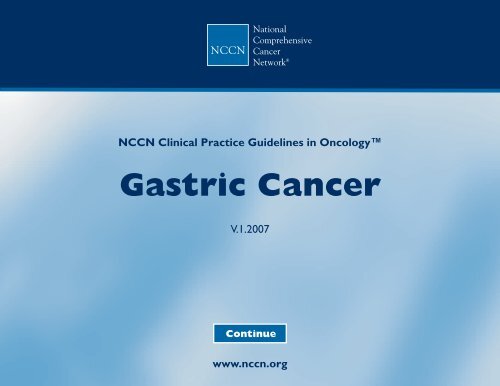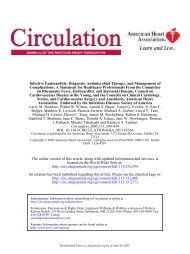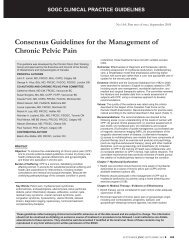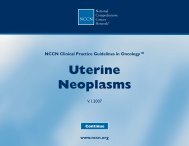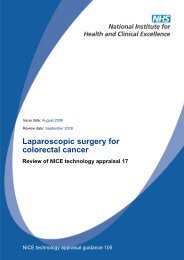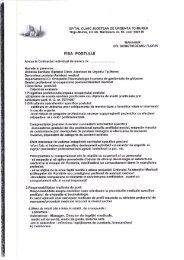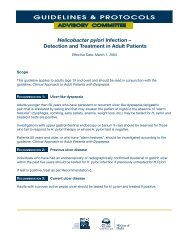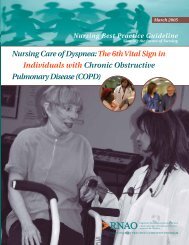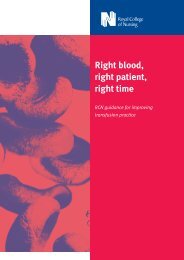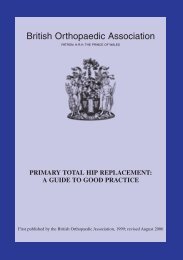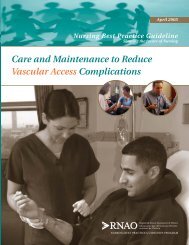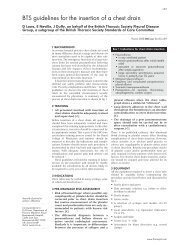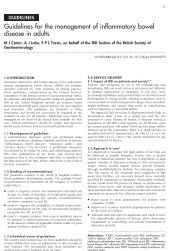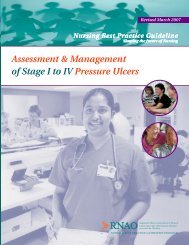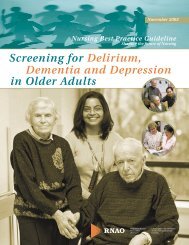Practice Guidelines in Oncology - Gastric Cancer
Practice Guidelines in Oncology - Gastric Cancer
Practice Guidelines in Oncology - Gastric Cancer
You also want an ePaper? Increase the reach of your titles
YUMPU automatically turns print PDFs into web optimized ePapers that Google loves.
NCCN Cl<strong>in</strong>ical <strong>Practice</strong> <strong>Guidel<strong>in</strong>es</strong> <strong>in</strong> <strong>Oncology</strong><br />
<strong>Gastric</strong> <strong>Cancer</strong><br />
V.1.2007<br />
Cont<strong>in</strong>ue<br />
www.nccn.org
®<br />
<strong>Practice</strong> <strong>Guidel<strong>in</strong>es</strong><br />
NCCN <strong>in</strong> <strong>Oncology</strong> – v.1.2007<br />
* Jaffer Ajani, MD/Chair †¤<br />
The University of Texas M. D. Anderson<br />
<strong>Cancer</strong> Center<br />
* Tanios Bekaii-Saab, MD †<br />
Arthur G. James <strong>Cancer</strong> Hospital &<br />
Richard J. Solove Research Institute at<br />
The Ohio State University<br />
* Thomas A. D’Amico, MD <br />
Duke Comprehensive <strong>Cancer</strong> Center<br />
Charles Fuchs, MD †<br />
Dana-Farber/Brigham and Women’s<br />
<strong>Cancer</strong> Center | Massachusetts General<br />
Hospital <strong>Cancer</strong> Center<br />
Michael K. Gibson, MD †Þ<br />
The Sidney Kimmel Comprehensive<br />
<strong>Cancer</strong> Center at Johns Hopk<strong>in</strong>s<br />
Melvyn Goldberg, MD <br />
Fox Chase <strong>Cancer</strong> Center<br />
James A. Hayman, MD, MBA §<br />
University of Michigan Comprehensive<br />
<strong>Cancer</strong> Center<br />
† Medical oncology<br />
¤ Gastroenterology<br />
Surgery/Surgical oncology<br />
Þ Internal medic<strong>in</strong>e<br />
§ Radiotherapy/Radiation oncology<br />
‡ Hematology/Hematology oncology<br />
*Writ<strong>in</strong>g committee member<br />
<strong>Gastric</strong> <strong>Cancer</strong><br />
NCCN <strong>Gastric</strong> <strong>Cancer</strong> Panel Members<br />
David H. Ilson, MD, PhD †Þ<br />
Memorial Sloan-Ketter<strong>in</strong>g <strong>Cancer</strong> Center<br />
Mil<strong>in</strong>d Javle, MD †<br />
Roswell Park <strong>Cancer</strong> Institute<br />
Scott T. Kelley, MD <br />
H. Lee Moffitt <strong>Cancer</strong> Center and Research<br />
Institute at the University of South Florida<br />
Robert C. Kurtz, MD ¤Þ<br />
Memorial Sloan-Ketter<strong>in</strong>g <strong>Cancer</strong> Center<br />
Gershon Yehuda Locker, MD †<br />
Robert H. Lurie Comprehensive <strong>Cancer</strong><br />
Center at Northwestern University<br />
Neal J. Meropol, MD †<br />
Fox Chase <strong>Cancer</strong> Center<br />
Bruce D. M<strong>in</strong>sky, MD §<br />
Memorial Sloan-Ketter<strong>in</strong>g <strong>Cancer</strong> Center<br />
Mark B. Orr<strong>in</strong>ger, MD <br />
University of Michigan Comprehensive<br />
<strong>Cancer</strong> Center<br />
Cont<strong>in</strong>ue<br />
Version 1.2007, 03/09/07 © 2007 National Comprehensive <strong>Cancer</strong> Network, Inc. All rights reserved. These guidel<strong>in</strong>es and this illustration may not be reproduced <strong>in</strong> any form without the express written permission of NCCN.<br />
<strong>Guidel<strong>in</strong>es</strong> Index<br />
<strong>Gastric</strong> Table of Contents<br />
Stag<strong>in</strong>g, MS, References<br />
Raymond U. Osarogiagbon, MD †Þ‡<br />
St. Jude Children’s Research<br />
Hospital/University of Tennessee <strong>Cancer</strong><br />
Institute<br />
James A. Posey, MD †<br />
University of Alabama at Birm<strong>in</strong>gham<br />
Comprehensive <strong>Cancer</strong> Center<br />
Jack Roth, MD <br />
The University of Texas M.D. Anderson<br />
<strong>Cancer</strong> Center<br />
* Aaron R. Sasson, MD <br />
UNMC Eppley <strong>Cancer</strong> Center at The<br />
Nebraska Medical Center<br />
Stephen G. Swisher, MD <br />
The University of Texas M. D. Anderson<br />
<strong>Cancer</strong> Center<br />
Douglas E. Wood, MD <br />
Fred Hutch<strong>in</strong>son <strong>Cancer</strong> Research<br />
Center/Seattle <strong>Cancer</strong> Care Alliance<br />
Gary Yang, MD §<br />
Roswell Park <strong>Cancer</strong> Institute<br />
Yun Yen, MD, PhD ‡<br />
City of Hope <strong>Cancer</strong> Center
®<br />
<strong>Practice</strong> <strong>Guidel<strong>in</strong>es</strong><br />
NCCN <strong>in</strong> <strong>Oncology</strong> – v.1.2007<br />
Table of Contents<br />
NCCN <strong>Gastric</strong> <strong>Cancer</strong> Panel Members<br />
Workup and Evaluation (GAST-1)<br />
Postlaparoscopy Stag<strong>in</strong>g and Treatment (GAST-2)<br />
Adjunctive Treatment (GAST-3)<br />
Follow-up and Salvage Therapy (GAST-4)<br />
Pr<strong>in</strong>ciples of Surgery (GAST-A)<br />
Pr<strong>in</strong>ciples of Systemic Therapy (GAST-B)<br />
<strong>Guidel<strong>in</strong>es</strong> Index<br />
Pr<strong>in</strong>t the <strong>Gastric</strong> <strong>Cancer</strong> Guidel<strong>in</strong>e<br />
<strong>Gastric</strong> <strong>Cancer</strong><br />
Version 1.2007, 03/09/07 © 2007 National Comprehensive <strong>Cancer</strong> Network, Inc. All rights reserved. These guidel<strong>in</strong>es and this illustration may not be reproduced <strong>in</strong> any form without the express written permission of NCCN.<br />
<strong>Guidel<strong>in</strong>es</strong> Index<br />
<strong>Gastric</strong> Table of Contents<br />
Stag<strong>in</strong>g, MS, References<br />
For help us<strong>in</strong>g these<br />
documents, please click here<br />
Stag<strong>in</strong>g<br />
Manuscript<br />
References<br />
This manuscript is be<strong>in</strong>g<br />
updated to correspond<br />
with the newly updated<br />
algorithm.<br />
Cl<strong>in</strong>ical Trials: The NCCN<br />
believes that the best management<br />
for any cancer patient is <strong>in</strong> a cl<strong>in</strong>ical<br />
trial. Participation <strong>in</strong> cl<strong>in</strong>ical trials is<br />
especially encouraged.<br />
To f<strong>in</strong>d cl<strong>in</strong>ical trials onl<strong>in</strong>e at NCCN<br />
member <strong>in</strong>stitutions, click here:<br />
nccn.org/cl<strong>in</strong>ical_trials/physician.html<br />
NCCN Categories of Consensus:<br />
All recommendations are Category<br />
2A unless otherwise specified.<br />
See NCCN Categories of Consensus<br />
Summary of <strong>Guidel<strong>in</strong>es</strong> Updates<br />
These guidel<strong>in</strong>es are a statement of consensus of the authors regard<strong>in</strong>g their views of currently accepted approaches to treatment. Any cl<strong>in</strong>ician<br />
seek<strong>in</strong>g to apply or consult these guidel<strong>in</strong>es is expected to use <strong>in</strong>dependent medical judgment <strong>in</strong> the context of <strong>in</strong>dividual cl<strong>in</strong>ical circumstances to<br />
determ<strong>in</strong>e any patient's care or treatment. The National Comprehensive <strong>Cancer</strong> Network makes no representations nor warranties of any k<strong>in</strong>d<br />
whatsoever regard<strong>in</strong>g their content, use, or application and disclaims any responsibility for their application or use <strong>in</strong> any way. These guidel<strong>in</strong>es are<br />
copyrighted by National Comprehensive <strong>Cancer</strong> Network. All rights reserved. These guidel<strong>in</strong>es and the illustrations here<strong>in</strong> may not be reproduced <strong>in</strong><br />
any form without the express written permission of NCCN. ©2007.
®<br />
<strong>Practice</strong> <strong>Guidel<strong>in</strong>es</strong><br />
NCCN <strong>in</strong> <strong>Oncology</strong> – v.1.2007<br />
Summary of the <strong>Guidel<strong>in</strong>es</strong> Updates<br />
<strong>Gastric</strong> <strong>Cancer</strong><br />
Summary of major changes <strong>in</strong> the 1.2007 version of the <strong>Gastric</strong> <strong>Cancer</strong> guidel<strong>in</strong>es from the 2006 version <strong>in</strong>clude:<br />
( GAST-1):<br />
� Additional Evaluation: Laparoscopic recommendations were condensed and changed to “Consider laparoscopy (category 2B)”<br />
� Added new footnote “a” regard<strong>in</strong>g the appropriateness of PET/CT scans for T1 or M1 patients<br />
( GAST-2):<br />
� Medically fit, potentially resectable: M0 pathway revised to <strong>in</strong>clude T1 and T2 tumors<br />
� Added new footnote “d” about surgery as primary treatment for treatment for T1 cancer<br />
( GAST-A)<br />
� A new page entitled, “Pr<strong>in</strong>ciples of Surgery” was added to outl<strong>in</strong>e recommended guidel<strong>in</strong>es for gastric surgery<br />
( GAST-B):<br />
� All category of consensus recommendations for systemic therapies were revised to reflect current data<br />
� Preoperative Chemotherapy: Added “ECF”<br />
� Postoperative Chemotherapy: Added “ECF”<br />
� “5-FU” was changed to “fluoropyrimid<strong>in</strong>e” throughout page<br />
Note: All recommendations are category 2A unless otherwise <strong>in</strong>dicated.<br />
Cl<strong>in</strong>ical Trials: NCCN believes that the best management of any cancer patient is <strong>in</strong> a cl<strong>in</strong>ical trial. Participation <strong>in</strong> cl<strong>in</strong>ical trials is especially encouraged.<br />
Version 1.2007, 03/09/07 © 2007 National Comprehensive <strong>Cancer</strong> Network, Inc. All rights reserved. These guidel<strong>in</strong>es and this illustration may not be reproduced <strong>in</strong> any form without the express written permission of NCCN.<br />
<strong>Guidel<strong>in</strong>es</strong> Index<br />
<strong>Gastric</strong> Table of Contents<br />
Stag<strong>in</strong>g, MS, References<br />
UPDATES
®<br />
<strong>Practice</strong> <strong>Guidel<strong>in</strong>es</strong><br />
NCCN <strong>in</strong> <strong>Oncology</strong> – v.1.2007<br />
WORKUP<br />
� Multidiscipl<strong>in</strong>ary<br />
evaluation<br />
� H&P<br />
� CBC, platelets, SMA-12<br />
� Abdom<strong>in</strong>al CT<br />
� CT/ultrasound pelvis<br />
(females)<br />
� Chest x-ray<br />
� Esophagogastroduodenoscopy<br />
� PET/CT scana a<br />
b<br />
c<br />
CLINICAL<br />
PRESENTATION<br />
Locoregional<br />
(M0)<br />
Stage IV<br />
(M1)<br />
<strong>Gastric</strong> <strong>Cancer</strong><br />
Medically fit, b<br />
potentially<br />
resectable<br />
Medically fit, b<br />
unresectable<br />
Medically unfit<br />
May not be appropriate for T1 or M1 patients.<br />
Medically able to tolerate major abdom<strong>in</strong>al surgery.<br />
Laparoscopy is performed to evaluate for peritoneal spread when consider<strong>in</strong>g chemotherapy/RT or surgery.<br />
Laparoscopy is not <strong>in</strong>dicated if a palliative resection is planned.<br />
ADDITIONAL<br />
EVALUATION<br />
Cosider<br />
Laparoscopyc<br />
(category 2B)<br />
Note: All recommendations are category 2A unless otherwise <strong>in</strong>dicated.<br />
Cl<strong>in</strong>ical Trials: NCCN believes that the best management of any cancer patient is <strong>in</strong> a cl<strong>in</strong>ical trial. Participation <strong>in</strong> cl<strong>in</strong>ical trials is especially encouraged.<br />
Version 1.2007, 03/09/07 © 2007 National Comprehensive <strong>Cancer</strong> Network, Inc. All rights reserved. These guidel<strong>in</strong>es and this illustration may not be reproduced <strong>in</strong> any form without the express written permission of NCCN.<br />
<strong>Guidel<strong>in</strong>es</strong> Index<br />
<strong>Gastric</strong> Table of Contents<br />
Stag<strong>in</strong>g, MS, References<br />
Postlaparoscopy<br />
Stag<strong>in</strong>g (see GAST-2)<br />
Salvage Therapy<br />
(see GAST-4)<br />
GAST-1
®<br />
<strong>Practice</strong> <strong>Guidel<strong>in</strong>es</strong><br />
NCCN <strong>in</strong> <strong>Oncology</strong> – v.1.2007<br />
Medically fit, b<br />
potentially<br />
resectable<br />
Medically fit, b<br />
unresectable<br />
Medically<br />
unfit<br />
b<br />
d<br />
POSTLAPAROSCOPY<br />
STAGING<br />
M0<br />
M1<br />
M0<br />
M1<br />
M0<br />
M1<br />
T1 or less<br />
(by cl<strong>in</strong>ical stag<strong>in</strong>g)<br />
T2 or higher<br />
(by cl<strong>in</strong>ical<br />
stag<strong>in</strong>g or N+)<br />
<strong>Gastric</strong> <strong>Cancer</strong><br />
PRIMARY<br />
TREATMENT<br />
Surgery d,e<br />
Surgery<br />
RT, 45-50.4 Gy + concurrent<br />
5-FU-based radiosensitization (category 1)<br />
or Chemotherapy f<br />
Salvage Therapy<br />
(see GAST-4)<br />
RT, 45–50.4 Gy + concurrent<br />
5-FU-based radiosensitization<br />
(category 1)<br />
or<br />
Salvage Therapy<br />
(see GAST-4)<br />
Salvage Therapy<br />
(see GAST-4)<br />
Medically able to tolerate major abdom<strong>in</strong>al surgery.<br />
Surgery as primary therapy is appropriate for T1 cancer or actively bleed<strong>in</strong>g cancer, or when postoperative adjuvant therapy is preferred.<br />
eSee<br />
Pr<strong>in</strong>ciples of Surgery (GAST-A) .<br />
fSee<br />
Pr<strong>in</strong>ciples of Systemic Therapy (GAST-B) .<br />
Note: All recommendations are category 2A unless otherwise <strong>in</strong>dicated.<br />
Cl<strong>in</strong>ical Trials: NCCN believes that the best management of any cancer patient is <strong>in</strong> a cl<strong>in</strong>ical trial. Participation <strong>in</strong> cl<strong>in</strong>ical trials is especially encouraged.<br />
or<br />
Version 1.2007, 03/09/07 © 2007 National Comprehensive <strong>Cancer</strong> Network, Inc. All rights reserved. These guidel<strong>in</strong>es and this illustration may not be reproduced <strong>in</strong> any form without the express written permission of NCCN.<br />
e<br />
Preoperative<br />
chemotherapyf<br />
Salvage Therapy<br />
(see GAST-4)<br />
Surgery e<br />
<strong>Guidel<strong>in</strong>es</strong> Index<br />
<strong>Gastric</strong> Table of Contents<br />
Stag<strong>in</strong>g, MS, References<br />
Surgical Outcomes<br />
(see GAST-3)<br />
Adjunctive Treatment<br />
Postchemotherapy ± RT<br />
(see GAST-3)<br />
Adjunctive Treatment<br />
Postchemotherapy ± RT<br />
(see GAST-3)<br />
GAST-2
®<br />
<strong>Practice</strong> <strong>Guidel<strong>in</strong>es</strong><br />
NCCN <strong>in</strong> <strong>Oncology</strong> – v.1.2007<br />
Surgical<br />
outcomes<br />
SURGICAL RESECTION<br />
R0 resection<br />
R1 resection<br />
R2 resection<br />
T1, N0<br />
T2, N0<br />
<strong>Gastric</strong> <strong>Cancer</strong><br />
T3, T4 or<br />
Any T, N+<br />
ADJUNCTIVE TREATMENT<br />
RT, 45–50.4 Gy + concurrent<br />
5-FU-based radiosensitization (preferred)<br />
+ 5-FU ± leucovor<strong>in</strong><br />
RT, 45–50.4 Gy + concurrent<br />
5-FU-based radiosensitization<br />
Note: All recommendations are category 2A unless otherwise <strong>in</strong>dicated.<br />
Cl<strong>in</strong>ical Trials: NCCN believes that the best management of any cancer patient is <strong>in</strong> a cl<strong>in</strong>ical trial. Participation <strong>in</strong> cl<strong>in</strong>ical trials is especially encouraged.<br />
or<br />
Chemotherapy<br />
or<br />
Best supportive care<br />
(poor performance status)<br />
Version 1.2007, 03/09/07 © 2007 National Comprehensive <strong>Cancer</strong> Network, Inc. All rights reserved. These guidel<strong>in</strong>es and this illustration may not be reproduced <strong>in</strong> any form without the express written permission of NCCN.<br />
f<br />
Observe<br />
<strong>Guidel<strong>in</strong>es</strong> Index<br />
<strong>Gastric</strong> Table of Contents<br />
Stag<strong>in</strong>g, MS, References<br />
Follow-up (see GAST-4)<br />
Observe or Chemotherapy<br />
( 5-FU-based)/RT<br />
for selected patientsg<br />
RT, 45–50.4 Gy + concurrent<br />
5-FU-based<br />
radiosensitization (preferred)<br />
+ 5-FU ± leucovor<strong>in</strong><br />
Follow-up (see GAST-4)<br />
Salvage Therapy (see GAST-4)<br />
M1 Salvage Therapy (see GAST-4)<br />
Restag<strong>in</strong>g (preferred):<br />
� Chest x-ray<br />
Adjunctive<br />
� Abdom<strong>in</strong>al CT<br />
treatment,<br />
� Pelvic imag<strong>in</strong>g<br />
postchemo-<br />
(females)<br />
therapy ± RT<br />
� CBC, SMA-12<br />
� PET/CT scan<br />
eSee<br />
Pr<strong>in</strong>ciples of Surgery (GAST-A) .<br />
fSee<br />
Pr<strong>in</strong>ciples of Systemic Therapy (GAST-B) .<br />
Complete response<br />
or major response<br />
Residual,<br />
locoregional<br />
and/or<br />
distant metastases<br />
Follow-up<br />
(see GAST-4)<br />
or<br />
Surgery, e if<br />
appropriate<br />
Salvage Therapy (see GAST-4)<br />
gHigh risk features such as poorly differentiated or higher grade cancer, lymphovascular <strong>in</strong>vasion, neural <strong>in</strong>vasion, or < 50 years of age.<br />
f<br />
GAST-3
®<br />
<strong>Practice</strong> <strong>Guidel<strong>in</strong>es</strong><br />
NCCN <strong>in</strong> <strong>Oncology</strong> – v.1.2007<br />
FOLLOW-UP<br />
� H&P every 4-6mofor3y,<br />
then annually<br />
� CBC, platelets, SMA-12, as<br />
<strong>in</strong>dicated<br />
� Radiologic imag<strong>in</strong>g or<br />
endoscopy, as cl<strong>in</strong>ically<br />
<strong>in</strong>dicated<br />
� Monitor vitam<strong>in</strong> B12 for<br />
proximal or total<br />
gastrectomy patientsh<br />
SALVAGE THERAPY<br />
Karnofsky performance<br />
score > 60<br />
or<br />
ECOG performance<br />
score � 2<br />
Karnofsky performance<br />
score � 60<br />
or<br />
ECOG performance<br />
score � 3<br />
fSee<br />
Pr<strong>in</strong>ciples of Systemic Therapy (GAST-B).<br />
hPatients should be monitored for vitam<strong>in</strong> B12 deficiency and treated as <strong>in</strong>dicated.<br />
<strong>Gastric</strong> <strong>Cancer</strong><br />
Chemotherapy<br />
or<br />
Cl<strong>in</strong>ical trial<br />
Best<br />
supportive<br />
care<br />
Note: All recommendations are category 2A unless otherwise <strong>in</strong>dicated.<br />
Cl<strong>in</strong>ical Trials: NCCN believes that the best management of any cancer patient is <strong>in</strong> a cl<strong>in</strong>ical trial. Participation <strong>in</strong> cl<strong>in</strong>ical trials is especially encouraged.<br />
Version 1.2007, 03/09/07 © 2007 National Comprehensive <strong>Cancer</strong> Network, Inc. All rights reserved. These guidel<strong>in</strong>es and this illustration may not be reproduced <strong>in</strong> any form without the express written permission of NCCN.<br />
or<br />
Best supportive<br />
care<br />
f<br />
<strong>Guidel<strong>in</strong>es</strong> Index<br />
<strong>Gastric</strong> Table of Contents<br />
Stag<strong>in</strong>g, MS, References<br />
Supportive Care Modalities<br />
� Obstruction: Stent, laser,<br />
photodynamic therapy, RT, surgery<br />
� Nutrition: Enteral feed<strong>in</strong>g, nutritional<br />
counsel<strong>in</strong>g<br />
� Pa<strong>in</strong> control: RT and/or medications<br />
� Bleed<strong>in</strong>g: RT, surgery or endoscopic<br />
therapy<br />
GAST-4
®<br />
<strong>Practice</strong> <strong>Guidel<strong>in</strong>es</strong><br />
NCCN <strong>in</strong> <strong>Oncology</strong> – v.1.2007<br />
Surgery<br />
<strong>Gastric</strong> <strong>Cancer</strong><br />
PRINCIPLES OF SURGERY<br />
Type:<br />
� Distal (body + antrum): prefer subtotal gastrectomy<br />
� Proximal (cardia): total or proximal gastrectomy, as <strong>in</strong>dicated<br />
� Splenectomy: avoid if possible<br />
� Consider plac<strong>in</strong>g a feed<strong>in</strong>g jejunostomy tube<br />
� Prefer >5cmproximal and distal marg<strong>in</strong>s from gross tumor<br />
Criteria for unresectability for cure:<br />
� Peritoneal seed<strong>in</strong>g or distant metastases<br />
� Inability to perform a complete resection<br />
� Invasion or encasement of major vascular structure<br />
Extent of lymph node dissection recommended:<br />
� D0: unacceptable<br />
� M<strong>in</strong>imum of 15 lymph nodes should be evaluated<br />
Note: All recommendations are category 2A unless otherwise <strong>in</strong>dicated.<br />
Cl<strong>in</strong>ical Trials: NCCN believes that the best management of any cancer patient is <strong>in</strong> a cl<strong>in</strong>ical trial. Participation <strong>in</strong> cl<strong>in</strong>ical trials is especially encouraged.<br />
Version 1.2007, 03/09/07 © 2007 National Comprehensive <strong>Cancer</strong> Network, Inc. All rights reserved. These guidel<strong>in</strong>es and this illustration may not be reproduced <strong>in</strong> any form without the express written permission of NCCN.<br />
<strong>Guidel<strong>in</strong>es</strong> Index<br />
<strong>Gastric</strong> Table of Contents<br />
Stag<strong>in</strong>g, MS, References<br />
GAST-A
®<br />
<strong>Practice</strong> <strong>Guidel<strong>in</strong>es</strong><br />
NCCN <strong>in</strong> <strong>Oncology</strong> – v.1.2007<br />
Preoperative Chemotherapy:<br />
� ECF (category 1)<br />
Preoperative Chemoradiation<br />
(Recommended <strong>in</strong> localized unresectable case) :<br />
� Fluoropyrimid<strong>in</strong>e/leucovor<strong>in</strong> (category 2B)<br />
� Fluoropyrimid<strong>in</strong>e-based (category 2B)<br />
� Cisplat<strong>in</strong>-based (category 2B)<br />
� Taxane-based (category 2B)<br />
� Ir<strong>in</strong>otecan-based (category 2B)<br />
Postoperative Chemoradiation:<br />
� Fluoropyrimid<strong>in</strong>e/leucovor<strong>in</strong> (category 1)<br />
� Fluoropyrimid<strong>in</strong>e-based (category 1)<br />
� Fluoropyrimid<strong>in</strong>e/cisplat<strong>in</strong> (category 2B)<br />
� ECF (category 2B)<br />
� Taxane-based (category 2B)<br />
<strong>Gastric</strong> <strong>Cancer</strong><br />
PRINCIPLES OF SYSTEMIC THERAPY<br />
Postoperative Chemotherapy:<br />
� ECF (Only when preoperative ECF has been adm<strong>in</strong>istered)<br />
(category 1)<br />
Metastatic <strong>Cancer</strong>:<br />
� Fluoropyrimid<strong>in</strong>e/leucovor<strong>in</strong> (category 2B)<br />
� Fluoropyrimid<strong>in</strong>e-based (category 2B)<br />
� Cisplat<strong>in</strong>-based (category 2B)<br />
� Oxaliplat<strong>in</strong>-based (category 2B)<br />
� Taxane-based (category 1)<br />
� Ir<strong>in</strong>otecan-based (category 2B)<br />
� ECF (category 1)<br />
Version 1.2007, 03/09/07 © 2007 National Comprehensive <strong>Cancer</strong> Network, Inc. All rights reserved. These guidel<strong>in</strong>es and this illustration may not be reproduced <strong>in</strong> any form without the express written permission of NCCN.<br />
<strong>Guidel<strong>in</strong>es</strong> Index<br />
<strong>Gastric</strong> Table of Contents<br />
Stag<strong>in</strong>g, MS, References<br />
� For resected gastric carc<strong>in</strong>oma, only f luoropyrimid<strong>in</strong>e/leucovor<strong>in</strong><br />
has been studied <strong>in</strong> conjunction with radiation therapy <strong>in</strong> a phase III<br />
sett<strong>in</strong>g (Intergroup 116). 1 However, many participat<strong>in</strong>g <strong>in</strong>stitutions have developed chemotherapy variations <strong>in</strong> the context of phase II<br />
studies. Thus, many regimens <strong>in</strong>dicated below represent <strong>in</strong>stitutional preferences but they may not be superior to<br />
f luoropyrimid<strong>in</strong>e/leucovor<strong>in</strong>.<br />
� For metastatic gastric carc<strong>in</strong>oma: there have been only a few phase III trials (experimental arms be<strong>in</strong>g: ECF (Epirubic<strong>in</strong>/cisplat<strong>in</strong>/5-FU),<br />
DCF (Docetaxel/cisplat<strong>in</strong>/5-FU), and FOLFIRI (AIO regimen Infusional 5-FU/leucovor<strong>in</strong>/ir<strong>in</strong>otecan). The regimens <strong>in</strong>dicated below <strong>in</strong>clude<br />
<strong>in</strong>stitutional preferences <strong>in</strong> the context of phase II trials. The regimens not studied <strong>in</strong> the phase III sett<strong>in</strong>g may not be superior to DCF or<br />
ECF.<br />
� It should be noted that there is no established second-l<strong>in</strong>e therapy for advanced gastric cancer. Moreover, many regimens may be<br />
considered as reference regimens <strong>in</strong> the first-l<strong>in</strong>e sett<strong>in</strong>g.<br />
1Macdonald JS, Smalley SR, Benedetti J, et al. Chemoradiotherapy after surgery compared with surgery alone for adenocarc<strong>in</strong>oma of the stomach or gastroesophageal<br />
junction. N Engl J Med. Sep 6;345(10):725-30, 2001.<br />
Note: All recommendations are category 2A unless otherwise <strong>in</strong>dicated.<br />
Cl<strong>in</strong>ical Trials: NCCN believes that the best management of any cancer patient is <strong>in</strong> a cl<strong>in</strong>ical trial. Participation <strong>in</strong> cl<strong>in</strong>ical trials is especially encouraged.<br />
GAST-B
®<br />
<strong>Practice</strong> <strong>Guidel<strong>in</strong>es</strong><br />
NCCN <strong>in</strong> <strong>Oncology</strong> – v.1.2007<br />
Stag<strong>in</strong>g<br />
Table 1<br />
American Jo<strong>in</strong>t Committee on <strong>Cancer</strong> (AJCC) TNM Stag<strong>in</strong>g<br />
Classification for Carc<strong>in</strong>oma of the Stomach*<br />
Primary Tumor (T)<br />
TX Primary tumor cannot be assessed<br />
T0 No evidence of primary tumor<br />
Tis Carc<strong>in</strong>oma <strong>in</strong> situ: <strong>in</strong>traepithelial tumor without <strong>in</strong>vasion of the<br />
lam<strong>in</strong>a propria<br />
T1 Tumor <strong>in</strong>vades lam<strong>in</strong>a propria or submucosa<br />
T2 Tumor <strong>in</strong>vades muscularis propria or subserosa†<br />
T2a Tumor <strong>in</strong>vades muscularis propria<br />
T2b Tumor <strong>in</strong>vades subserosa<br />
T3 Tumor penetrates serosa (visceral peritoneum) without<br />
<strong>in</strong>vasion of adjacent structures‡<br />
T4 Tumor <strong>in</strong>vades adjacent structures‡<br />
Regional Lymph Nodes (N)<br />
NX Regional lymph node(s) cannot be assessed<br />
N0 No regional lymph node metastasis§<br />
N1 Metastasis <strong>in</strong> 1 to 6 regional lymph nodes<br />
N2 Metastasis <strong>in</strong> 7 to 15 regional lymph nodes<br />
N3 Metastasis <strong>in</strong> more than 15 regional lymph nodes<br />
Distant Metastasis (M)<br />
MX Distant metastasis cannot be assessed<br />
M0 No distant metastasis<br />
M1 Distant metastasis<br />
Histologic Grade (G)<br />
GX Grade cannot be assessed<br />
G1 Well differentiated<br />
G2 Moderately differentiated<br />
G3 Poorly differentiated<br />
G4 Undifferentiated<br />
<strong>Gastric</strong> <strong>Cancer</strong><br />
Stage Group<strong>in</strong>g<br />
Stage 0 Tis N0 M0<br />
Stage IA T1 N0 M0<br />
Stage IB T1 N1 M0<br />
T2a/b N0 M0<br />
Stage II T1 N2 M0<br />
T2a/b N1 M0<br />
T3 N0 M0<br />
Stage IIIA T2a/b N2 M0<br />
T3 N1 M0<br />
T4 N0 M0<br />
Stage IIIB T3 N2 M0<br />
Stage IV T4 N1-3 M0<br />
T1-3 N3 M0<br />
Any T Any N M1<br />
Version 1.2007, 03/09/07 © 2007 National Comprehensive <strong>Cancer</strong> Network, Inc. All rights reserved. These guidel<strong>in</strong>es and this illustration may not be reproduced <strong>in</strong> any form without the express written permission of NCCN.<br />
<strong>Guidel<strong>in</strong>es</strong> Index<br />
<strong>Gastric</strong> Table of Contents<br />
Stag<strong>in</strong>g, MS, References<br />
*Used with permission of the American Jo<strong>in</strong>t Committee on <strong>Cancer</strong><br />
(AJCC), Chicago, Ill<strong>in</strong>ois. The orig<strong>in</strong>al and primary source for this<br />
<strong>in</strong>formation is the AJCC <strong>Cancer</strong> Stag<strong>in</strong>g Manual, Sixth Edition (2002)<br />
published by Spr<strong>in</strong>ger-Verlag New York. (For more <strong>in</strong>formation, visit<br />
www.cancerstag<strong>in</strong>g.net.)<br />
Any citation or quotation of this material must be<br />
credited to the AJCC as its primary source. The <strong>in</strong>clusion of this<br />
<strong>in</strong>formation here<strong>in</strong> does not authorize any reuse or further distribution<br />
without the expressed written permission of Spr<strong>in</strong>ger-Verlag New York on<br />
behalf of the AJCC.<br />
†A tumor may penetrate the muscularis propria with extension <strong>in</strong>to the<br />
gastrocolic or gastrohepatic ligaments, or <strong>in</strong>to the greater or lesser<br />
omentum, without perforation of the visceral peritoneum cover<strong>in</strong>g these<br />
structures. In this case, the tumor is classified as T2. If there is perforation<br />
of the visceral peritoneum cover<strong>in</strong>g the gastric ligaments or the omentum,<br />
the tumor should be classified as T3.<br />
‡The adjacent structures of the stomach <strong>in</strong>clude the spleen, transverse<br />
colon, liver, diaphragm, pancreas, abdom<strong>in</strong>al wall, adrenal gland, kidney,<br />
small <strong>in</strong>test<strong>in</strong>e, and retroperitoneum. Intramural extension to the<br />
duodenum or esophagus is classified by the depth of the greatest <strong>in</strong>vasion<br />
<strong>in</strong> any of these sites, <strong>in</strong>clud<strong>in</strong>g the stomach.<br />
§A designation of pN0 should be used if all exam<strong>in</strong>ed lymph nodes are<br />
negative, regardless of the total number removed and exam<strong>in</strong>ed.<br />
ST-1
®<br />
<strong>Practice</strong> <strong>Guidel<strong>in</strong>es</strong><br />
NCCN <strong>in</strong> <strong>Oncology</strong> – v.1.2007<br />
Manuscript<br />
NCCN Categories of Consensus<br />
This manuscript is be<strong>in</strong>g updated to correspond<br />
with the newly updated algorithm.<br />
Category 1:<br />
There is uniform NCCN consensus, based on high-level<br />
evidence, that the recommendation is appropriate.<br />
Category 2A:<br />
There is uniform NCCN consensus, based on lowerlevel<br />
evidence <strong>in</strong>clud<strong>in</strong>g cl<strong>in</strong>ical experience, that the<br />
recommendation is appropriate.<br />
Category 2B:<br />
There is nonuniform NCCN consensus (but no major<br />
disagreement), based on lower-level evidence <strong>in</strong>clud<strong>in</strong>g cl<strong>in</strong>ical<br />
experience, that the recommendation is appropriate.<br />
Category 3:<br />
There is major NCCN disagreement that the<br />
recommendation is appropriate.<br />
All recommendations are category 2A unless otherwise noted.<br />
Overview<br />
Carc<strong>in</strong>omas orig<strong>in</strong>at<strong>in</strong>g <strong>in</strong> the upper gastro<strong>in</strong>test<strong>in</strong>al (GI) tract (esophagus,<br />
gastroesophageal junction, and stomach) constitute a major<br />
health problem around the world. It is estimated that approximately<br />
36,830 new cases of upper GI carc<strong>in</strong>omas and 25,200 deaths will<br />
1<br />
occur <strong>in</strong> the United States <strong>in</strong> 2006. There has been a dramatic shift <strong>in</strong><br />
2<br />
the location of upper GI tumors <strong>in</strong> the United States. Changes <strong>in</strong><br />
histology as well as location of upper GI tumors have also been<br />
3-5<br />
observed <strong>in</strong> some parts of Europe. In countries <strong>in</strong> the Western<br />
Hemisphere, gastric carc<strong>in</strong>oma has migrated proximally; it occurs most<br />
frequently along the proximal lesser curvature, <strong>in</strong> the cardia, and <strong>in</strong> the<br />
2<br />
gastroesophageal junction. It is possible that <strong>in</strong> the com<strong>in</strong>g decades<br />
these chang<strong>in</strong>g trends will also occur <strong>in</strong> South America and Asia.<br />
<strong>Gastric</strong> <strong>Cancer</strong><br />
Manuscript<br />
update <strong>in</strong><br />
progress<br />
Version 1.2007, 03/09/07 © 2007 National Comprehensive <strong>Cancer</strong> Network, Inc. All rights reserved. These guidel<strong>in</strong>es and this illustration may not be reproduced <strong>in</strong> any form without the express written permission of NCCN.<br />
<strong>Guidel<strong>in</strong>es</strong> Index<br />
<strong>Gastric</strong> Table of Contents<br />
Stag<strong>in</strong>g, MS, References<br />
Epidemiology of <strong>Gastric</strong> Carc<strong>in</strong>oma<br />
<strong>Gastric</strong> carc<strong>in</strong>oma is rampant <strong>in</strong> many countries around the world.<br />
By some estimates, it is the second most common malignant<br />
disorder worldwide. Its <strong>in</strong>cidence, however, has been decl<strong>in</strong><strong>in</strong>g<br />
globally s<strong>in</strong>ce World War II. <strong>Gastric</strong> carc<strong>in</strong>oma is one of the least<br />
common cancers <strong>in</strong> North America. Nevertheless, it rema<strong>in</strong>s the<br />
eighth lead<strong>in</strong>g cause of cancer death <strong>in</strong> the United States. In 2006,<br />
more than 22,280 new cases of gastric cancer are estimated to<br />
occur <strong>in</strong> the United States and 11,430 deaths are expected as a<br />
1<br />
result. In developed countries, the <strong>in</strong>cidence of gastric cancer<br />
localized to the cardia follows the distribution of esophageal cancer;<br />
however, unlike the latter, the rates of gastric cancer have stabilized<br />
6-8<br />
s<strong>in</strong>ce 1998. Noncardia gastric adenocarc<strong>in</strong>oma also shows<br />
marked geographic variation; thus, countries such as Japan, Costa<br />
Rica, Peru, Brazil, Ch<strong>in</strong>a, Korea, Chile, Taiwan, and the former<br />
9,10<br />
Soviet Union show a high <strong>in</strong>cidence of the cancer. In Japan,<br />
gastric cancer rema<strong>in</strong>s the most common type of cancer among<br />
men. In contrast to the <strong>in</strong>creas<strong>in</strong>g <strong>in</strong>cidence of proximal tumors <strong>in</strong><br />
the West, non-proximal tumors cont<strong>in</strong>ue to predom<strong>in</strong>ate <strong>in</strong> Japan<br />
11,12<br />
and other parts of the world. The cause of this shift rema<strong>in</strong>s<br />
elusive and may be multifactorial.<br />
<strong>Gastric</strong> carc<strong>in</strong>oma is often diagnosed at an advanced stage,<br />
because screen<strong>in</strong>g for gastric carc<strong>in</strong>oma is not performed <strong>in</strong> most of<br />
the world, except <strong>in</strong> Japan (and <strong>in</strong> a limited fashion <strong>in</strong> Korea) where<br />
early detection of gastric carc<strong>in</strong>oma is often done. Thus, gastric<br />
carc<strong>in</strong>oma cont<strong>in</strong>ues to pose a major challenge for healthcare<br />
professionals. Risk factors <strong>in</strong>clude Helicobacter pylori <strong>in</strong>fection,<br />
smok<strong>in</strong>g, high salt <strong>in</strong>take, and other dietary factors. A few gastric<br />
cancers (1%-3%) are associated with <strong>in</strong>herited gastric cancer<br />
predisposition syndromes. E-cadher<strong>in</strong> mutations occur <strong>in</strong> an<br />
MS-1
®<br />
<strong>Practice</strong> <strong>Guidel<strong>in</strong>es</strong><br />
NCCN <strong>in</strong> <strong>Oncology</strong> – v.1.2007<br />
estimated 25% of families with an autosomal dom<strong>in</strong>ant<br />
predisposition to diffuse type gastric cancers; this subset of gastric<br />
cancer has been termed hereditary diffuse gastric cancer. Data<br />
suggest it may be useful to provide genetic counsel<strong>in</strong>g and to<br />
consider prophylactic gastrectomy <strong>in</strong> young, asymptomatic carriers<br />
of germ-l<strong>in</strong>e truncat<strong>in</strong>g CDH1 mutations who belong to families with<br />
highly penetrant hereditary diffuse gastric cancer.<br />
13<br />
14<br />
Stag<strong>in</strong>g<br />
Two major classification systems are currently <strong>in</strong> use for gastric<br />
carc<strong>in</strong>oma. The most elaborate of these, the Japanese<br />
classification, is based on ref<strong>in</strong>ed anatomic <strong>in</strong>volvement, particularly<br />
15<br />
the lymph node stations. The other stag<strong>in</strong>g system for gastric<br />
carc<strong>in</strong>oma, developed jo<strong>in</strong>tly by the American Jo<strong>in</strong>t Committee on<br />
<strong>Cancer</strong> (AJCC) and the International Union Aga<strong>in</strong>st <strong>Cancer</strong> (UICC),<br />
is based on a gastric cancer database and demonstrates that the<br />
prognosis of node-positive patients depends on the number of lymph<br />
16<br />
nodes <strong>in</strong>volved. The modern stag<strong>in</strong>g of gastric carc<strong>in</strong>oma is based<br />
on this tumor/node/metastasis (TNM) classification, rather than on<br />
the size of the cancer. The AJCC/UICC classification (see Table 1)<br />
is<br />
the system used <strong>in</strong> countries <strong>in</strong> the Western Hemisphere.<br />
Patient outcome depends on the <strong>in</strong>itial stage of the cancer at<br />
diagnosis. However, at diagnosis, approximately 50% of patients<br />
have gastric carc<strong>in</strong>oma that extends beyond the locoregional<br />
conf<strong>in</strong>es. In addition, approximately 50% of patients with<br />
locoregional gastric carc<strong>in</strong>oma cannot undergo a curative resection<br />
17,18<br />
(R0). Note that the R classification refers to the amount of<br />
residual cancer rema<strong>in</strong><strong>in</strong>g after tumor resection: R0 <strong>in</strong>dicates no<br />
macroscopic or microscopic cancer at resection marg<strong>in</strong>s (ie,<br />
negative marg<strong>in</strong>s); R1 <strong>in</strong>dicates microscopic residual cancer (ie,<br />
<strong>Gastric</strong> <strong>Cancer</strong><br />
Manuscript<br />
update Surgery<strong>in</strong><br />
progress<br />
Version 1.2007, 03/09/07 © 2007 National Comprehensive <strong>Cancer</strong> Network, Inc. All rights reserved. These guidel<strong>in</strong>es and this illustration may not be reproduced <strong>in</strong> any form without the express written permission of NCCN.<br />
<strong>Guidel<strong>in</strong>es</strong> Index<br />
<strong>Gastric</strong> Table of Contents<br />
Stag<strong>in</strong>g, MS, References<br />
positive marg<strong>in</strong>s); and R2 <strong>in</strong>dicates gross (macroscopic) residual<br />
19<br />
cancer (ie, positive marg<strong>in</strong>s) but not distant disease. Although<br />
surgical pathology yields the most accurate stage, cl<strong>in</strong>ical stag<strong>in</strong>g<br />
has been greatly improved by advancements <strong>in</strong> imag<strong>in</strong>g techniques,<br />
<strong>in</strong>clud<strong>in</strong>g laparoscopic evaluation of the peritoneal cavity and liver<br />
as well as endoscopic ultrasonography to assess the primary tumor<br />
20<br />
and regional lymph nodes. Nearly 70% to 80% of resected gastric<br />
carc<strong>in</strong>oma specimens have metastases <strong>in</strong> the regional lymph nodes.<br />
Thus, it is common to encounter patients with advanced gastric<br />
carc<strong>in</strong>oma at presentation. Poor prognostic factors <strong>in</strong> patients with<br />
locally advanced and metastatic esophago-gastric cancer <strong>in</strong>clude:<br />
poor performance status (2 or more), liver metastases, peritoneal<br />
21<br />
metastases, and alkal<strong>in</strong>e phosphatase of 100 U/L or more.<br />
Surgical therapy is the primary treatment for gastric carc<strong>in</strong>oma.<br />
Widely agreed on surgical pr<strong>in</strong>ciples for the management of gastric<br />
cancer <strong>in</strong>clude complete resection with adequate marg<strong>in</strong>s (5 cm).<br />
The type of resection (subtotal versus total gastrectomy) and the<br />
role of extensive lymphadenectomy have been the subjects of<br />
<strong>in</strong>ternational debate.<br />
For distal gastric cancers, subtotal gastrectomy has been shown to<br />
have an equivalent oncologic result with significantly fewer<br />
22<br />
complications when compared with total gastrectomy. The surgical<br />
procedure of choice for proximal gastric cancers is more<br />
controversial, because both procedures (proximal gastrectomy and<br />
total gastrectomy) are associated with postoperative nutritional<br />
impairments. Currently, most authorities advocate total gastrectomy<br />
for proximal (cardia) tumors.<br />
MS-2
®<br />
<strong>Practice</strong> <strong>Guidel<strong>in</strong>es</strong><br />
NCCN <strong>in</strong> <strong>Oncology</strong> – v.1.2007<br />
Even more controversial is the extent of lymphatic dissection that is<br />
required. The Japanese Research Society for the Study of <strong>Gastric</strong><br />
<strong>Cancer</strong> has established guidel<strong>in</strong>es for pathologic exam<strong>in</strong>ation and<br />
12<br />
evaluation of lymph node stations that surround the stomach. The<br />
perigastric lymph node stations along the lesser curvature (stations<br />
1, 3, and 5) and greater curvature (stations 2, 4, and 6) of the<br />
stomach are grouped together as N1. The nodes along the left<br />
gastric artery (station 7), common hepatic artery (station 8), celiac<br />
artery (station 9), and splenic artery (stations 10 and 11) are<br />
grouped together as N2. More distant nodes, <strong>in</strong>clud<strong>in</strong>g para-aortic<br />
(N3 and N4), are regarded as distant metastases.<br />
A D1 dissection entails the removal of the <strong>in</strong>volved distal part of the<br />
stomach or the entire stomach (distal or total resection), <strong>in</strong>clud<strong>in</strong>g<br />
the greater and lesser omenta. For a D2 dissection, the omental<br />
bursa is removed, along with the front leaf of the transverse<br />
mesocolon, and the mentioned arteries are cleared completely. A<br />
splenectomy (to remove stations 10 and 11) is required for a D2<br />
dissection for proximal gastric tumors. If N1 lymph nodes are not<br />
removed, then this is def<strong>in</strong>ed as a D0 dissection. The technical<br />
aspects of perform<strong>in</strong>g a D2 dissection require a significant degree of<br />
tra<strong>in</strong><strong>in</strong>g and expertise. In an Intergroup trial exam<strong>in</strong><strong>in</strong>g the role of<br />
adjuvant therapy for gastric cancer, 54% of the patients had a D0<br />
lymphadenectomy, whereas only 10% of patients had the<br />
23<br />
recommended D2 lymphadenectomy.<br />
Japanese <strong>in</strong>vestigators have often emphasized the value of<br />
extensive lymphadenectomy (D2 and above); however, Western<br />
<strong>in</strong>vestigators have not found a survival advantage when extensive<br />
24<br />
lymphadenectomy is compared with a D1 resection. The Dutch<br />
<strong>Gastric</strong> <strong>Cancer</strong> Group Trial recently published long-term survival<br />
25<br />
data compar<strong>in</strong>g D1 versus D2 resection. A total of 711 patients who<br />
<strong>Gastric</strong> <strong>Cancer</strong><br />
Manuscript<br />
update <strong>in</strong><br />
progress<br />
Version 1.2007, 03/09/07 © 2007 National Comprehensive <strong>Cancer</strong> Network, Inc. All rights reserved. These guidel<strong>in</strong>es and this illustration may not be reproduced <strong>in</strong> any form without the express written permission of NCCN.<br />
<strong>Guidel<strong>in</strong>es</strong> Index<br />
<strong>Gastric</strong> Table of Contents<br />
Stag<strong>in</strong>g, MS, References<br />
underwent surgical resection with curative <strong>in</strong>tent were randomly<br />
assigned to either a D1 or D2 lymphadenectomy. When compared<br />
with the D1 dissection, both the morbidity (25% versus 43%, P <<br />
.001) and mortality (4% versus 10%, P = .004) were higher for the<br />
D2 dissection, with no difference <strong>in</strong> overall survival (30% versus<br />
35%, P = .53). The authors identified splenectomy, pancreatectomy,<br />
and age older than 70 years as contribut<strong>in</strong>g risk factors for<br />
<strong>in</strong>creased morbidity and mortality. In a subset analysis, a trend to<br />
improved survival appeared to occur <strong>in</strong> patients with N2 cancer<br />
undergo<strong>in</strong>g a D2 lymphadenectomy. Unfortunately, N2 cancer can<br />
only be detected after microscopic exam<strong>in</strong>ation of the surgical<br />
specimen. A similar study conducted by the Medical Research<br />
Council failed to demonstrate a survival benefit of D2 over D1<br />
26<br />
lymphadenectomy. In addition, the D2 dissection was associated<br />
with <strong>in</strong>creased morbidity and mortality. A meta-analysis did not show<br />
any survival benefit from extended lymph node dissections but did<br />
27<br />
show <strong>in</strong>creased mortality.<br />
Despite these results, <strong>in</strong>terest <strong>in</strong> extended lymphatic dissections (D2<br />
28<br />
and greater) has not waned. Investigators have argued that if the<br />
complication rate after a D2 operation could be decreased then<br />
there may be a benefit <strong>in</strong> selected patients. A recent phase II study<br />
of D2 dissection by the Italian <strong>Gastric</strong> <strong>Cancer</strong> Study Group (IGCSG)<br />
has demonstrated a morbidity of 20.9% and a postoperative<br />
29<br />
mortality rate of 3%. These rates are comparable to the rates for<br />
D1 dissections <strong>in</strong> the Dutch and United K<strong>in</strong>gdom trial. The difference<br />
<strong>in</strong> the IGCSG trial was the lack of rout<strong>in</strong>e pancreatectomy <strong>in</strong> patients<br />
with proximal gastric tumors (except when warranted for direct<br />
<strong>in</strong>vasion). Japanese <strong>in</strong>vestigators compar<strong>in</strong>g D2 versus extended<br />
D2 (<strong>in</strong>clud<strong>in</strong>g para-aortic lymph nodes) have recently reported a<br />
30<br />
postoperative morality rate of 0.8% <strong>in</strong> each arm. Survival data from<br />
MS-3
®<br />
<strong>Practice</strong> <strong>Guidel<strong>in</strong>es</strong><br />
NCCN <strong>in</strong> <strong>Oncology</strong> – v.1.2007<br />
this study are currently not available. A surgical option that may<br />
decrease morbidity and mortality is an “over-D1” (ie, D1+)<br />
lymphadenectomy with preservation of the pancreatic tail and<br />
31, 32<br />
without splenectomy.<br />
With improvements <strong>in</strong> endoscopic techniques (endoscopic mucosal<br />
resection [EMR]) and m<strong>in</strong>imal access surgery (laparoscopic wedge<br />
resection), there has been <strong>in</strong>terest <strong>in</strong> apply<strong>in</strong>g these modalities to<br />
early gastric cancer (T1, mucosal and submucosal). Node-negative<br />
33<br />
T1 tumors are associated with a 5-year survival of more than 90%.<br />
As such, there is <strong>in</strong>terest <strong>in</strong> perform<strong>in</strong>g more limited resection for<br />
these tumors. Proper patient selection is paramount when<br />
employ<strong>in</strong>g endoscopic or limited gastric resections (wedge). The<br />
probability of lymph node metastasis <strong>in</strong> early gastric cancer is<br />
<strong>in</strong>fluenced by tumor factors and is <strong>in</strong>creased with <strong>in</strong>creas<strong>in</strong>g tumor<br />
size, submucosal <strong>in</strong>vasion, poorly differentiated tumors, and<br />
34<br />
lymphatic and vascular <strong>in</strong>vasion. Indications for EMR <strong>in</strong>clude welldifferentiated<br />
or moderately differentiated histology, tumor size less<br />
than 30 mm, absence of ulceration, and no evidence of <strong>in</strong>vasive<br />
35<br />
f<strong>in</strong>d<strong>in</strong>gs. Regardless of the technique used for resect<strong>in</strong>g early<br />
gastric tumors, complete excision with negative marg<strong>in</strong>s is required.<br />
Endoscopic ultrasound may be useful <strong>in</strong> assess<strong>in</strong>g the depth of<br />
36,37<br />
tumor <strong>in</strong>vasion and may aid <strong>in</strong> appropriate patient selection. Most<br />
of the experience with EMR for early gastric cancer has been ga<strong>in</strong>ed<br />
by countries with a high <strong>in</strong>cidence of gastric cancer and an active<br />
38<br />
screen<strong>in</strong>g program. The applicability of these techniques <strong>in</strong> the<br />
United States is limited because of the low <strong>in</strong>cidence of early gastric<br />
cancer. Furthermore, long-term follow-up and survival data are<br />
lack<strong>in</strong>g therefore, the rout<strong>in</strong>e use of endoscopic techniques is not<br />
recommended outside a cl<strong>in</strong>ical trial and should be limited to<br />
medical centers with extensive experience.<br />
<strong>Gastric</strong> <strong>Cancer</strong><br />
Radiotherapy and Chemoradiation<br />
Manuscript<br />
update <strong>in</strong><br />
progress<br />
Version 1.2007, 03/09/07 © 2007 National Comprehensive <strong>Cancer</strong> Network, Inc. All rights reserved. These guidel<strong>in</strong>es and this illustration may not be reproduced <strong>in</strong> any form without the express written permission of NCCN.<br />
<strong>Guidel<strong>in</strong>es</strong> Index<br />
<strong>Gastric</strong> Table of Contents<br />
Stag<strong>in</strong>g, MS, References<br />
Locally Unresectable <strong>Cancer</strong><br />
Moderate-dose external-beam radiation (45-50.4 Gy) as a s<strong>in</strong>gle<br />
modality has m<strong>in</strong>imal value <strong>in</strong> palliat<strong>in</strong>g locally unresectable gastric<br />
39<br />
carc<strong>in</strong>oma and does not improve survival. However, when used<br />
concurrently with 5-fluorouracil (5-FU), moderate-dose external-beam<br />
40<br />
radiation does improve survival. Moertel and colleagues assessed<br />
5-FU plus 35 to 40 Gy of radiotherapy compared with radiotherapy<br />
alone <strong>in</strong> the treatment of locally unresectable gastric carc<strong>in</strong>oma. They<br />
observed a 6-month survival advantage <strong>in</strong> the group receiv<strong>in</strong>g comb<strong>in</strong>ed<br />
modality therapy. In another study by the Gastro<strong>in</strong>test<strong>in</strong>al<br />
Tumor Study Group, 90 patients with locally advanced gastric carc<strong>in</strong>oma<br />
were randomly assigned to receive either comb<strong>in</strong>ation chemotherapy<br />
(5-FU plus methyl-CCNU [lomust<strong>in</strong>e]) or split-course radiation<br />
therapy (RT) with a concurrent <strong>in</strong>travenous bolus of 5-FU given<br />
dur<strong>in</strong>g the first 3 days of 2 sessions of 25 Gy, separated by a 2-week<br />
41<br />
break, and followed by ma<strong>in</strong>tenance 5-FU plus methyl-CCNU. In the<br />
first 26 weeks, mortality was higher <strong>in</strong> the comb<strong>in</strong>ed modality group.<br />
At 3 years, however, the survival curve reached a plateau <strong>in</strong> the<br />
comb<strong>in</strong>ed modality arm, but tumor-related deaths cont<strong>in</strong>ued to occur<br />
<strong>in</strong> the chemotherapy-alone arm, suggest<strong>in</strong>g that a small fraction of<br />
patients can be cured with comb<strong>in</strong>ed modality therapy.<br />
This approach needs to be further developed <strong>in</strong> light of newly<br />
available radioenhancers. New agents---such as taxanes,<br />
epirubic<strong>in</strong>, and ir<strong>in</strong>otecan---have been used <strong>in</strong> comb<strong>in</strong>ation with<br />
42-44<br />
RT. Results of the comparative trials are pend<strong>in</strong>g.<br />
Preoperative or Postoperative Chemotherapy<br />
Recent studies suggest that preoperative <strong>in</strong>duction chemotherapy<br />
followed by chemoradiotherapy yields a substantial pathologic<br />
MS-4
®<br />
<strong>Practice</strong> <strong>Guidel<strong>in</strong>es</strong><br />
NCCN <strong>in</strong> <strong>Oncology</strong> – v.1.2007<br />
45,46<br />
response that results <strong>in</strong> durable survival time. However, the value<br />
of such approaches needs to be determ<strong>in</strong>ed <strong>in</strong> comparative trials.<br />
47<br />
Nonrandomized trials from Baeza and colleagues have reported<br />
encourag<strong>in</strong>g results for patients with R0 resections who receive<br />
adjunctive treatment. Limited reports from randomized trials of<br />
postoperative RT with or without chemotherapy after a complete<br />
resection with negative marg<strong>in</strong>s did not reveal a clear survival<br />
48,49<br />
advantage.<br />
23,50<br />
The landmark trial is the Intergroup trial INT-0116. Eligibility<br />
<strong>in</strong>cluded patients with T3 and/or N+ adenocarc<strong>in</strong>oma of the stomach<br />
or gastroesophageal junction. After a resection with negative<br />
marg<strong>in</strong>s, 603 patients were randomly assigned to either observation<br />
alone or postoperative comb<strong>in</strong>ed modality therapy consist<strong>in</strong>g of 5<br />
monthly cycles of bolus chemotherapy with 45 Gy concurrent with<br />
cycles 2 and 3. There was a significant decrease <strong>in</strong> local failure as<br />
the first site of failure (19% versus 29%) as well as an <strong>in</strong>crease <strong>in</strong><br />
median survival (36 versus 27 months), 3-year relapse-free survival<br />
(48% versus 31%), and overall survival (50% versus 41%, P = .005)<br />
with comb<strong>in</strong>ed modality therapy. The CALGB 80101 phase III trial is<br />
currently assess<strong>in</strong>g postoperative standard therapy with 5-<br />
FU/leucovor<strong>in</strong>/radiation versus ECF (epirubic<strong>in</strong>, cisplat<strong>in</strong>, and 5-<br />
FU)/radiation<br />
( http://www.nci.nih.gov/search/ViewCl<strong>in</strong>icalTrials.aspx?cdrid=25878<br />
7&version=patient&protocolsearchid=1575831).<br />
51<br />
Smalley and colleagues reviewed gastric anatomy and patterns of<br />
failure after surgery, and they offer detailed radiation treatment<br />
plann<strong>in</strong>g recommendations. A randomized trial by Zhang and<br />
associates from Beij<strong>in</strong>g revealed a significant improvement <strong>in</strong><br />
52<br />
survival with preoperative radiation (30% versus 20%, P = .0094).<br />
<strong>Gastric</strong> <strong>Cancer</strong><br />
Manuscript<br />
update <strong>in</strong><br />
progress<br />
Version 1.2007, 03/09/07 © 2007 National Comprehensive <strong>Cancer</strong> Network, Inc. All rights reserved. These guidel<strong>in</strong>es and this illustration may not be reproduced <strong>in</strong> any form without the express written permission of NCCN.<br />
<strong>Guidel<strong>in</strong>es</strong> Index<br />
<strong>Gastric</strong> Table of Contents<br />
Stag<strong>in</strong>g, MS, References<br />
These data suggest that preoperative radiation improves local<br />
control and survival. However, randomized trials are needed to<br />
confirm these results <strong>in</strong> patients from the Western Hemisphere.<br />
The sem<strong>in</strong>al trial exam<strong>in</strong><strong>in</strong>g the role of postoperative comb<strong>in</strong>ed<br />
modality therapy <strong>in</strong> gastric cancer was reported by Moertel and<br />
40<br />
colleagues <strong>in</strong> 1969 (40 Gy versus 40 Gy plus 5-FU). This trial<br />
revealed a significant improvement <strong>in</strong> survival. The rema<strong>in</strong><strong>in</strong>g<br />
randomized trials <strong>in</strong>clude patients with unresectable or residual<br />
cancer. None have shown a survival advantage. The use of<br />
<strong>in</strong>traoperative RT rema<strong>in</strong>s <strong>in</strong>vestigational.<br />
For resected gastric carc<strong>in</strong>oma, only 5-FU/leucovor<strong>in</strong> (category 1)<br />
has been studied <strong>in</strong> conjunction with RT <strong>in</strong> a phase III sett<strong>in</strong>g<br />
23<br />
(Intergroup 116). However, many participat<strong>in</strong>g <strong>in</strong>stitutions have<br />
developed other chemotherapy regimens <strong>in</strong> the context of phase II<br />
studies. Thus, these regimens represent <strong>in</strong>stitutional preferences,<br />
but they may not be superior to 5-FU/leucovor<strong>in</strong>. In the NCCN<br />
algorithm, preoperative chemoradiation options for localized,<br />
unresectable disease <strong>in</strong>clude 5-FU/leucovor<strong>in</strong> (category 1) as well<br />
as the follow<strong>in</strong>g category 3 options such as 5-FU--based, cisplat<strong>in</strong>based,<br />
taxane-based, and ir<strong>in</strong>otecan-based regimens. Postoperative<br />
chemoradiation options <strong>in</strong>clude 5-FU/leucovor<strong>in</strong> (category 1) as well<br />
as the follow<strong>in</strong>g category 3 options such as 5-FU/cisplat<strong>in</strong>, 5-FUbased,<br />
taxane-based, and ECF regimens.<br />
Chemotherapy<br />
Advanced gastric carc<strong>in</strong>oma is <strong>in</strong>curable, but chemotherapy can<br />
have a palliative effect <strong>in</strong> symptomatic patients. In four studies,<br />
comb<strong>in</strong>ation chemotherapy resulted <strong>in</strong> better quality of life and<br />
overall survival when compared with best supportive care <strong>in</strong> patients<br />
53-56<br />
with advanced gastric carc<strong>in</strong>oma. However, all four studies only<br />
MS-5
®<br />
<strong>Practice</strong> <strong>Guidel<strong>in</strong>es</strong><br />
NCCN <strong>in</strong> <strong>Oncology</strong> – v.1.2007<br />
had a small number of patients. Only a few s<strong>in</strong>gle agents have<br />
established activity aga<strong>in</strong>st advanced gastric carc<strong>in</strong>oma; these<br />
57 58<br />
agents <strong>in</strong>clude 5-FU, mitomyc<strong>in</strong>, etoposide, and cisplat<strong>in</strong>.<br />
In the early 1980s, the FAM (5-FU, doxorubic<strong>in</strong>, and mitomyc<strong>in</strong>)<br />
regimen was the gold standard therapy for patients with advanced<br />
59<br />
gastric carc<strong>in</strong>oma. In a pivotal study performed by the North<br />
60<br />
Central <strong>Cancer</strong> Treatment Group (NCCTG), the FAM regimen was<br />
compared with 5-FU as a s<strong>in</strong>gle agent and 5-FU plus doxorubic<strong>in</strong>.<br />
No significant survival difference was detected among patients<br />
treated with these three regimens. However, response rates were<br />
higher with comb<strong>in</strong>ation chemotherapy than with 5-FU alone. Thus,<br />
comb<strong>in</strong>ation chemotherapy is preferable to s<strong>in</strong>gle-agent therapy for<br />
palliation.<br />
Several randomized studies compar<strong>in</strong>g FAM versus FAMTX (5-FU,<br />
61<br />
adriamyc<strong>in</strong>, and methotrexate [with leucovor<strong>in</strong> rescue]), FAMTX<br />
62<br />
versus ECF, and FAMTX versus ELF (etoposide, leucovor<strong>in</strong>, and 5-<br />
63<br />
FU) versus 5-FU plus cisplat<strong>in</strong> have been reported <strong>in</strong> the past<br />
several years. No one standard therapy has emerged from these<br />
trials. Outside of cl<strong>in</strong>ical trials, the recommended chemotherapy for<br />
advanced gastric carc<strong>in</strong>oma is either cisplat<strong>in</strong>-based or 5-FU--based<br />
comb<strong>in</strong>ation chemotherapy.<br />
Several drugs and their comb<strong>in</strong>ations have shown activity aga<strong>in</strong>st<br />
64-66 67-69<br />
gastric carc<strong>in</strong>oma. The agents <strong>in</strong>clude paclitaxel, docetaxel,<br />
70 71<br />
ir<strong>in</strong>otecan, UFT (a comb<strong>in</strong>ation of uracil and tegafur), oral<br />
72 73-77<br />
etoposide, and S-1. In addition, comb<strong>in</strong>ation chemotherapy<br />
78-89<br />
regimens have also been assessed. A number of oral agents also<br />
81,82<br />
hold promise <strong>in</strong> the treatment of gastric carc<strong>in</strong>oma. Agents that<br />
have not been extensively studied <strong>in</strong>clude capecitab<strong>in</strong>e, oxaliplat<strong>in</strong>,<br />
and rubitecan. In addition, several new categories of agents are of<br />
<strong>Gastric</strong> <strong>Cancer</strong><br />
Manuscript<br />
update <strong>in</strong><br />
progress<br />
Version 1.2007, 03/09/07 © 2007 National Comprehensive <strong>Cancer</strong> Network, Inc. All rights reserved. These guidel<strong>in</strong>es and this illustration may not be reproduced <strong>in</strong> any form without the express written permission of NCCN.<br />
<strong>Guidel<strong>in</strong>es</strong> Index<br />
<strong>Gastric</strong> Table of Contents<br />
Stag<strong>in</strong>g, MS, References<br />
<strong>in</strong>terest, <strong>in</strong>clud<strong>in</strong>g vacc<strong>in</strong>es, antireceptor agents, and antiangiogenic<br />
agents. A number of chemotherapy comb<strong>in</strong>ations are currently <strong>in</strong><br />
90,91<br />
phase III trials, and we anticipate that a widely accepted front-l<strong>in</strong>e<br />
standard for patients with advanced gastric carc<strong>in</strong>oma might emerge<br />
92<br />
<strong>in</strong> the near future. For metastatic gastric carc<strong>in</strong>oma, there have<br />
been only a few phase III trials, which have assessed ECF, DCF<br />
(docetaxel/cisplat<strong>in</strong>/5-FU), and FOLFIRI-AIO (<strong>in</strong>fusional 5-<br />
FU/leucovor<strong>in</strong>/ir<strong>in</strong>otecan). However, participat<strong>in</strong>g <strong>in</strong>stitutions have<br />
developed chemotherapy regimens <strong>in</strong> the context of phase II studies<br />
. The regimens that have not been studied <strong>in</strong> the phase III sett<strong>in</strong>g<br />
may not be superior to DCF or ECF. In the NCCN algorithm, options<br />
for metastatic cancer <strong>in</strong>clude 5-FU/leucovor<strong>in</strong> (category 1) as well<br />
as the follow<strong>in</strong>g category 3 options such as 5-FU--based<br />
(capecitab<strong>in</strong>e), cisplat<strong>in</strong>-based, oxaliplat<strong>in</strong>-based, taxane-based,<br />
ir<strong>in</strong>otecan-based, and ECF regimens. Moreover, many regimens<br />
may be considered as reference regimens <strong>in</strong> the first-l<strong>in</strong>e sett<strong>in</strong>g.<br />
There is no established second-l<strong>in</strong>e therapy for advanced gastric<br />
cancer.<br />
Workup<br />
In patients with gastric cancer, present<strong>in</strong>g symptoms can <strong>in</strong>clude<br />
anemia, early satiety, weight loss, and/or bleed<strong>in</strong>g. Newly diagnosed<br />
patients should undergo a complete history, physical exam<strong>in</strong>ation,<br />
chest x-ray, and endoscopy of the entire upper GI tract. A complete<br />
blood count (CBC), platelets, multichannel serum chemistry analysis<br />
(ie, SMA-12), coagulation studies, and a computed tomography (CT)<br />
scan of the abdomen should be performed; a positron emission<br />
tomography (PET) scan may also be useful, although there may be<br />
93<br />
false-positive results with PET. Comb<strong>in</strong>ed PET/CT imag<strong>in</strong>g is more<br />
94<br />
useful than either imag<strong>in</strong>g alone for preoperative stag<strong>in</strong>g. In<br />
MS-6
®<br />
<strong>Practice</strong> <strong>Guidel<strong>in</strong>es</strong><br />
NCCN <strong>in</strong> <strong>Oncology</strong> – v.1.2007<br />
women, a pelvic CT scan or ultrasound is also recommended.<br />
The workup permits classification of patients <strong>in</strong>to 1 of 2 groups: (1)<br />
patients with apparent locoregional carc<strong>in</strong>oma (stages I to III or M0),<br />
and (2) those with obvious metastatic carc<strong>in</strong>oma (stage IV or M1).<br />
Patients with apparent locoregional cancer can be further classified:<br />
(1) those who are medically fit (ie, able to tolerate major abdom<strong>in</strong>al<br />
surgery) and whose cancer is potentially resectable, (2) those who<br />
are medically fit but whose cancer is unresectable, and (3) those<br />
who are medically unfit.<br />
Additional Evaluation<br />
For the group of medically fit patients with apparent locoregional<br />
carc<strong>in</strong>oma, the guidel<strong>in</strong>es address the role of laparoscopy before<br />
def<strong>in</strong>itive surgery or comb<strong>in</strong>ed chemotherapy and radiation. The use of<br />
this stag<strong>in</strong>g procedure differs among the NCCN <strong>in</strong>stitutions, with<br />
several centers preferr<strong>in</strong>g laparoscopic stag<strong>in</strong>g of the peritoneal cavity<br />
for medically fit patients, whether <strong>in</strong> the potentially resectable or<br />
unresectable category (category 2B). For medically unfit patients with<br />
apparent locoregional carc<strong>in</strong>oma, laparoscopic stag<strong>in</strong>g of the peritoneal<br />
cavity can be done when consider<strong>in</strong>g chemotherapy/RT or surgery. If a<br />
palliative resection is planned, laparoscopy is not <strong>in</strong>dicated.<br />
Postlaparoscopic Stag<strong>in</strong>g<br />
If a laparoscopic exam<strong>in</strong>ation is performed, there are two<br />
possibilities for both medically fit and unfit patients with apparent<br />
locoregional carc<strong>in</strong>oma. Patients will either have apparent<br />
locoregional carc<strong>in</strong>oma or will have metastatic carc<strong>in</strong>oma (M1).<br />
Primary Therapy<br />
Surgery is recommended for medically fit patients with a potentially<br />
resectable (stages I to III) carc<strong>in</strong>oma. Medically fit patients<br />
<strong>Gastric</strong> <strong>Cancer</strong><br />
Manuscript<br />
update <strong>in</strong><br />
progress<br />
Version 1.2007, 03/09/07 © 2007 National Comprehensive <strong>Cancer</strong> Network, Inc. All rights reserved. These guidel<strong>in</strong>es and this illustration may not be reproduced <strong>in</strong> any form without the express written permission of NCCN.<br />
<strong>Guidel<strong>in</strong>es</strong> Index<br />
<strong>Gastric</strong> Table of Contents<br />
Stag<strong>in</strong>g, MS, References<br />
discovered to have an M1 carc<strong>in</strong>oma after laparoscopy may be<br />
offered salvage therapy. The goal of surgery is to accomplish a<br />
curative resection (R0) with negative marg<strong>in</strong>s, and 5 cm or greater<br />
proximal and distal marg<strong>in</strong>s are desirable. A D0 lymphadenectomy is<br />
unacceptable. It is recommended that at least 15 lymph nodes be<br />
removed and exam<strong>in</strong>ed. For carc<strong>in</strong>omas located <strong>in</strong> the distal<br />
stomach (body and antrum), a subtotal gastrectomy is preferred. For<br />
carc<strong>in</strong>omas located proximally (<strong>in</strong> the cardia), total gastrectomy is<br />
recommended; however, proximal gastrectomy may also be<br />
appropriate. Splenectomy should be avoided, if possible. Placement<br />
of a jejunostomy feed<strong>in</strong>g tube should be considered.<br />
Carc<strong>in</strong>omas are unresectable if there is evidence of peritoneal<br />
<strong>in</strong>volvement, distant metastases, or <strong>in</strong>vasion or encasement of<br />
major blood vessels. For medically fit patients found to have an<br />
unresectable locoregional cancer, the recommended therapy<br />
(category 1) is comb<strong>in</strong>ed RT (45 to 50.4 Gy) with concurrent 5-FU--<br />
40,41<br />
based radiosensitization. Medically unfit patients with<br />
locoregional carc<strong>in</strong>oma may be offered one of the follow<strong>in</strong>g choices:<br />
(1) RT (45 to 50.4 Gy) with concurrent 5-FU--based<br />
40,41<br />
radiosensitization (category 1); or (2) salvage chemotherapy with<br />
5-FU/leucovor<strong>in</strong> (category 1) or other agents which are category 3<br />
(such as ECF, 5-FU--based [capecitab<strong>in</strong>e], cisplat<strong>in</strong>-based,<br />
oxaliplat<strong>in</strong>-based, taxane-based, or ir<strong>in</strong>otecan-based<br />
chemotherapy). Medically unfit patients discovered to have M1<br />
carc<strong>in</strong>oma after laparoscopy may also be offered salvage therapy.<br />
Adjunctive Therapy<br />
As previously discussed, select patients with negative marg<strong>in</strong>s (R0<br />
resection) and no evidence of metastatic carc<strong>in</strong>oma after<br />
gastrectomy may receive adjuvant chemoradiation based on the<br />
MS-7
®<br />
<strong>Practice</strong> <strong>Guidel<strong>in</strong>es</strong><br />
NCCN <strong>in</strong> <strong>Oncology</strong> – v.1.2007<br />
results of the Intergroup trial (INT-0116). However, a patient whose<br />
surgical pathologic stage is T1, N0, M0 may be observed and not<br />
treated with adjuvant therapy. All patients with an R0 resection who<br />
have T2, N0 along with high-risk features (ie, poorly differentiated or<br />
higher grade cancer, lymphovascular <strong>in</strong>vasion, neural <strong>in</strong>vasion, or<br />
age younger than 50 years) should receive adjuvant<br />
chemoradiotherapy (5-FU--based/RT); those patients without highrisk<br />
features may be observed. The panel recommends that all<br />
patients with an R0 resection who have T3, T4, or any T, N+ cancer<br />
should be offered radiotherapy (45 to 50.4 Gy) plus concurrent<br />
5-FU--based radiosensitization (preferred) plus 5-FU with or without<br />
23,40<br />
leucovor<strong>in</strong>. It should also be noted that 20% of patients <strong>in</strong> the<br />
Intergroup-0116 trial had cancers that <strong>in</strong>volved the<br />
gastroesophageal junction; therefore, adjuvant chemoradiotherapy<br />
should also be recommended for patients with similar cancers<br />
(aga<strong>in</strong>, patients with T1, N0, M0 tumors may be observed as can<br />
patients with T2, N0 without high-risk features).<br />
Patients with R1 resections should be offered radiotherapy (45 to<br />
50.4 Gy) plus concurrent 5-FU--based radiosensitization (preferred)<br />
plus 5-FU with or without leucovor<strong>in</strong>. In the absence of M1<br />
carc<strong>in</strong>oma, patients with R2 resections may be offered (1) RT (45 to<br />
50.4 Gy) with concurrent 5-FU--based radiosensitization;<br />
(2) salvage chemotherapy; or (3) best supportive care, if<br />
performance status is poor. Medically unfit patients should undergo<br />
restag<strong>in</strong>g (<strong>in</strong>clud<strong>in</strong>g chest x-ray, abdom<strong>in</strong>al CT, CBC, SMA-12,<br />
pelvic imag<strong>in</strong>g [women], PET/CT scan) after completion of<br />
95<br />
chemoradiotherapy. If a complete response of the carc<strong>in</strong>oma is<br />
determ<strong>in</strong>ed, these patients should be observed or have surgery if it<br />
is deemed appropriate. If there is evidence of residual or M1 cancer,<br />
patients may be offered salvage therapy.<br />
<strong>Gastric</strong> <strong>Cancer</strong><br />
Follow-up and Surveillance<br />
Manuscript<br />
update <strong>in</strong><br />
progress<br />
Version 1.2007, 03/09/07 © 2007 National Comprehensive <strong>Cancer</strong> Network, Inc. All rights reserved. These guidel<strong>in</strong>es and this illustration may not be reproduced <strong>in</strong> any form without the express written permission of NCCN.<br />
<strong>Guidel<strong>in</strong>es</strong> Index<br />
<strong>Gastric</strong> Table of Contents<br />
Stag<strong>in</strong>g, MS, References<br />
All patients should be followed up systematically. This follow-up<br />
should <strong>in</strong>clude a complete history and physical exam<strong>in</strong>ation every 4<br />
to 6 months for 3 years, then annually thereafter. Complete blood<br />
count, platelets, SMA-12 tests, and other <strong>in</strong>vestigations (such as<br />
endoscopy and other radiologic studies) should be done if cl<strong>in</strong>ically<br />
96<br />
<strong>in</strong>dicated. Vitam<strong>in</strong> B12 levels should be monitored for patients who<br />
have had proximal or total gastrectomy.<br />
Salvage Therapy<br />
Salvage therapy consists of either best supportive care,<br />
chemotherapy, or cl<strong>in</strong>ical trial depend<strong>in</strong>g on the patient's<br />
performance scores on the Karnofsky or Eastern Cooperative Group<br />
(ECOG) scales. The constituents of best supportive care depend on<br />
the patient's symptoms. In the case of lum<strong>in</strong>al obstruction, a patient<br />
may be offered a stent placement, laser surgery, photodynamic<br />
therapy, radiotherapy, surgery, or a comb<strong>in</strong>ation of these methods,<br />
as appropriate. For patients requir<strong>in</strong>g nutritional support, placement<br />
of a percutaneous endoscopic gastronomy (PEG) tube may be<br />
97<br />
warranted; nutritional counsel<strong>in</strong>g may also be valuable. Pa<strong>in</strong><br />
control may be achieved with the use of radiotherapy plus pa<strong>in</strong><br />
medications. Similarly, surgery, endoscopic therapy, or radiotherapy<br />
may be <strong>in</strong>dicated <strong>in</strong> patients with brisk bleed<strong>in</strong>g from the carc<strong>in</strong>oma.<br />
Whenever possible, patients should be enrolled <strong>in</strong> cl<strong>in</strong>ical trials.<br />
Outside of a cl<strong>in</strong>ical trial, patients may be treated with 5-<br />
FU/leucovor<strong>in</strong> (category 1) or other agents, which are category 3<br />
(such as ECF, 5-FU—based [capecitab<strong>in</strong>e], cisplat<strong>in</strong>-based,<br />
oxaliplat<strong>in</strong>-based, taxane-based, or ir<strong>in</strong>otecan-based<br />
chemotherapy). The decision of whether to offer best supportive<br />
care alone or with chemotherapy should be based on the patient's<br />
MS-8
®<br />
<strong>Practice</strong> <strong>Guidel<strong>in</strong>es</strong><br />
NCCN <strong>in</strong> <strong>Oncology</strong> – v.1.2007<br />
performance status. Patients should be offered only best supportive<br />
care if they have a Karnofsky performance score of 60 or less, or an<br />
ECOG (Eastern Cooperative <strong>Oncology</strong> Group) performance score of<br />
3 or greater. Patients with a better performance status may be<br />
offered best supportive care alone, chemotherapy, or a cl<strong>in</strong>ical trial.<br />
Summary<br />
<strong>Gastric</strong> cancer is rampant <strong>in</strong> several countries around the world. Its<br />
<strong>in</strong>cidence <strong>in</strong> the Western Hemisphere has been on the decl<strong>in</strong>e for<br />
more than 40 years; however, the location of gastric cancer has<br />
shifted proximally <strong>in</strong> the past 15 years. The reason for this shift is<br />
not clear. Diffuse histology is also more common now than <strong>in</strong>test<strong>in</strong>al<br />
type of histology. Advances have been made <strong>in</strong> stag<strong>in</strong>g procedures,<br />
such as laparoscopy and endoscopic ultrasonography, and <strong>in</strong><br />
possible functional imag<strong>in</strong>g techniques. The current TNM<br />
classification requires an exam<strong>in</strong>ation of at least 15 lymph nodes; a<br />
D0 dissection is unacceptable. Patients with locoregional gastric<br />
carc<strong>in</strong>oma should also be referred to high-volume treatment centers.<br />
Comb<strong>in</strong>ation chemotherapy and radiotherapy <strong>in</strong> the adjuvant sett<strong>in</strong>g<br />
for a select group of patients is the new standard <strong>in</strong> the United<br />
States.<br />
The NCCN <strong>Gastric</strong> <strong>Cancer</strong> <strong>Guidel<strong>in</strong>es</strong> provide a uniform systematic<br />
approach to gastric cancer <strong>in</strong> the United States. We look forward to<br />
the results of <strong>in</strong>vestigations of new chemotherapeutic agents,<br />
<strong>in</strong>clud<strong>in</strong>g antireceptor agents, vacc<strong>in</strong>es, gene therapy, and<br />
antiangiogenic agents. The panel anticipates many advances <strong>in</strong> the<br />
treatment of gastric carc<strong>in</strong>oma <strong>in</strong> the future.<br />
<strong>Gastric</strong> <strong>Cancer</strong><br />
Manuscript<br />
update <strong>in</strong><br />
progress<br />
Version 1.2007, 03/09/07 © 2007 National Comprehensive <strong>Cancer</strong> Network, Inc. All rights reserved. These guidel<strong>in</strong>es and this illustration may not be reproduced <strong>in</strong> any form without the express written permission of NCCN.<br />
<strong>Guidel<strong>in</strong>es</strong> Index<br />
<strong>Gastric</strong> Table of Contents<br />
Stag<strong>in</strong>g, MS, References<br />
Disclosures for the NCCN <strong>Gastric</strong> <strong>Cancer</strong> <strong>Guidel<strong>in</strong>es</strong><br />
Panel<br />
At the beg<strong>in</strong>n<strong>in</strong>g of each panel meet<strong>in</strong>g to develop NCCN<br />
guidel<strong>in</strong>es, panel members disclosed the names of companies,<br />
foundations, and/or fund<strong>in</strong>g agencies from which they received<br />
research support; for which they participate <strong>in</strong> speakers' bureau,<br />
advisory boards; and/or <strong>in</strong> which they have equity <strong>in</strong>terest or<br />
patents. Members of the panel <strong>in</strong>dicated that they have received<br />
support from the follow<strong>in</strong>g: AstraZeneca; Berlex; Bristol Myers-<br />
Squibb; Discovery Laboratories, Inc; Exelixis; Genentech Inc;<br />
ImClone; Introgen Therapeutics, Inc; National <strong>Cancer</strong> Institute; OSI<br />
Pharmaceuticals, Inc; Pfizer Inc; Sanofi-Aventis; and U.S. Surgical.<br />
Some panel members do not accept any support from <strong>in</strong>dustry. The<br />
panel did not regard any potential conflicts of <strong>in</strong>terest as sufficient<br />
reason to disallow participation <strong>in</strong> panel deliberations by any<br />
member.<br />
MS-9
®<br />
<strong>Practice</strong> <strong>Guidel<strong>in</strong>es</strong><br />
NCCN <strong>in</strong> <strong>Oncology</strong> – v.1.2007<br />
References<br />
1. Jemal A, Siegel R, Ward E, et al. <strong>Cancer</strong> Statistics, 2006.<br />
CA <strong>Cancer</strong> J Cl<strong>in</strong> 2006;56:106-130.<br />
2. Blot WJ, Devesa SS, Kneller RW, et al. Ris<strong>in</strong>g <strong>in</strong>cidence of<br />
adenocarc<strong>in</strong>oma of the esophagus and gastric cardia. JAMA<br />
1991;265:1287-1289.<br />
3. Levi F, La Vecchia C. Adenocarc<strong>in</strong>oma of the esophagus <strong>in</strong><br />
Switzerland (letter). JAMA 1991;265:2960.<br />
4. Powell J, McConkey CC. Increas<strong>in</strong>g <strong>in</strong>cidence of adenocarc<strong>in</strong>oma<br />
of the gastric cardia and adjacent sites. Br J <strong>Cancer</strong> 1991;62:440-443.<br />
5. Reed PI. Chang<strong>in</strong>g pattern of esophageal cancer. Lancet<br />
1991;338:178.<br />
6. Powell J, McConkey CC, Gillison EW, et al. Cont<strong>in</strong>u<strong>in</strong>g ris<strong>in</strong>g trend<br />
<strong>in</strong> oesophageal adenocarc<strong>in</strong>oma. Int J <strong>Cancer</strong> 2002;102:422-427.<br />
7. Crew KD, Neugut AI. Epidemiology of upper gastro<strong>in</strong>test<strong>in</strong>al<br />
malignancies. Sem<strong>in</strong> Oncol 2004;31:450-464.<br />
8. Kubo A, Corley DA. Marked regional variation <strong>in</strong><br />
adenocarc<strong>in</strong>omas of the esophagus and the gastric cardia <strong>in</strong> the<br />
United States. <strong>Cancer</strong> 2002;95:2096-2102.<br />
9. Nomura A. Stomach cancer. In: <strong>Cancer</strong> Epidemiology and<br />
Prevention, 2nd edition. Shottenfeld D, Fraumeni JF, eds. New York:<br />
NY. Oxford University Press. 1996:707-724.<br />
10. Corley DA, Buffler PA. Oesophageal and gastric cardia adenocarc<strong>in</strong>omas:<br />
analysis of regional variation us<strong>in</strong>g the <strong>Cancer</strong> Incidence <strong>in</strong><br />
Five Cont<strong>in</strong>ents database. Int J Epidemiol 2001;30:1415-1425.<br />
<strong>Gastric</strong> <strong>Cancer</strong><br />
Manuscript<br />
update <strong>in</strong><br />
progress<br />
Version 1.2007, 03/09/07 © 2007 National Comprehensive <strong>Cancer</strong> Network, Inc. All rights reserved. These guidel<strong>in</strong>es and this illustration may not be reproduced <strong>in</strong> any form without the express written permission of NCCN.<br />
<strong>Guidel<strong>in</strong>es</strong> Index<br />
<strong>Gastric</strong> Table of Contents<br />
Stag<strong>in</strong>g, MS, References<br />
11. Park<strong>in</strong> DM, Muir CS. <strong>Cancer</strong> Incidence <strong>in</strong> Five Cont<strong>in</strong>ents.<br />
Comparability and quality of data. IARC Sci Publ 1992:45-173.<br />
12. Kajitani T, Japanese Research Society for the Study of <strong>Gastric</strong><br />
<strong>Cancer</strong>. The general rules for gastric cancer study <strong>in</strong> surgery and<br />
pathology. Jpn J Surg 1981;11:127-145.<br />
13. Fitzgerald RC, Caldas C. Cl<strong>in</strong>ical implications of E-cadher<strong>in</strong><br />
associated hereditary diffuse gastric cancer. Gut 2004;53:775-778.<br />
14. Huntsman DG, Carneiro F, Lewis FR, et al. Early gastric cancer<br />
<strong>in</strong> young, asymptomatic carriers of germ-l<strong>in</strong>e E-cadher<strong>in</strong> mutations.<br />
N Engl J Med 2001;344:1904-1909.<br />
15. Japanese Research Society for <strong>Gastric</strong> <strong>Cancer</strong>. The General<br />
Rules for the <strong>Gastric</strong> <strong>Cancer</strong> Study <strong>in</strong> Surgery and Pathology, 12th<br />
ed. Tokyo: Kanahara Shuppan, 1993.<br />
16. Roder JD, Bottcher K, Busch R, et al. Classification of regional<br />
lymph node metastasis from gastric carc<strong>in</strong>oma. German <strong>Gastric</strong><br />
<strong>Cancer</strong> Study Group. <strong>Cancer</strong> 1998;82:621-631.<br />
17. Leichman L, Silberman H, Leichman CG, et al. Preoperative<br />
systemic chemotherapy followed by adjuvant postoperative<br />
<strong>in</strong>traperitoneal therapy for gastric cancer: A University of Southern<br />
California pilot program. J Cl<strong>in</strong> Oncol 1992;10:1933-1942.<br />
18. Ajani JA, Mayer R, Ota DM, et al. Preoperative and<br />
postoperative comb<strong>in</strong>ation chemotherapy for potentially resectable<br />
gastric carc<strong>in</strong>oma. J Natl <strong>Cancer</strong> Inst 1993;85:1839-1844.<br />
19. Hermanek P, Wittek<strong>in</strong>d C. Residual tumor (R) classification and<br />
prognosis. Sem<strong>in</strong> Surg Oncol 1994;10:12-20.<br />
20. Weber WA, Ott K. Imag<strong>in</strong>g of esophageal and gastric cancer.<br />
Sem<strong>in</strong> Oncol 2004;31:530-541.<br />
REF-1
®<br />
<strong>Practice</strong> <strong>Guidel<strong>in</strong>es</strong><br />
NCCN <strong>in</strong> <strong>Oncology</strong> – v.1.2007<br />
21. Chau I, Norman AR, Cunn<strong>in</strong>gham D, et al. Multivariate<br />
prognostic factor analysis <strong>in</strong> locally advanced and metastatic<br />
esophago-gastric cancer--pooled analysis from three multicenter,<br />
randomized, controlled trials us<strong>in</strong>g <strong>in</strong>dividual patient data. J Cl<strong>in</strong><br />
Oncol 2004;22:2395-2403.<br />
22. Bozzetti F, Marub<strong>in</strong>i E, Bonfanti G, et al. Subtotal versus total<br />
gastrectomy for gastric cancer: five-year survival rates <strong>in</strong> a<br />
multicenter randomized Italian trial. Italian Gastro<strong>in</strong>test<strong>in</strong>al Tumor<br />
Study Group. Ann Surg 1999;230:170-178.<br />
23. MacDonald JS, Smalley SR, Benedetti J, et al.<br />
Chemoradiotherapy after surgery compared with surgery alone for<br />
adenocarc<strong>in</strong>oma of the stomach or gastroesophageal junction. N<br />
Engl J Med 2001;345:725-730.<br />
24. Bonenkamp JJ, Hermans J, Sasako M, et al. Extended lymphnode<br />
dissection for gastric cancer. Dutch <strong>Gastric</strong> <strong>Cancer</strong> Group. N<br />
Engl J Med 1999;340:908-914.<br />
25. Hartgr<strong>in</strong>k HH, van de Velde CJ, Putter H, et al. Extended lymph<br />
node dissection for gastric cancer: who may benefit? F<strong>in</strong>al results of<br />
the randomized Dutch gastric cancer group trial. J Cl<strong>in</strong> Oncol<br />
2004;22:2069-2077.<br />
26. Cuschieri A, Weeden S, Field<strong>in</strong>g J, et al. Patient survival after<br />
D1 and D2 resections for gastric cancer: long-term results of the<br />
MRC randomized surgical trial. Surgical Co-operative Group. Br J<br />
<strong>Cancer</strong> 1999;79:1522-1530.<br />
27. McCulloch P, Nita ME, Kazi H, et al. Extended versus limited<br />
lymph nodes dissection technique for adenocarc<strong>in</strong>oma of the<br />
stomach. Cochrane Database Syst Rev 2004;(4):CD001964.<br />
<strong>Gastric</strong> <strong>Cancer</strong><br />
Manuscript<br />
update <strong>in</strong><br />
progress<br />
Version 1.2007, 03/09/07 © 2007 National Comprehensive <strong>Cancer</strong> Network, Inc. All rights reserved. These guidel<strong>in</strong>es and this illustration may not be reproduced <strong>in</strong> any form without the express written permission of NCCN.<br />
<strong>Guidel<strong>in</strong>es</strong> Index<br />
<strong>Gastric</strong> Table of Contents<br />
Stag<strong>in</strong>g, MS, References<br />
28. Mansfield PF. Lymphadenectomy for gastric cancer. J Cl<strong>in</strong> Oncol<br />
2004;22:2759-2761.<br />
29. Degiuli M, Sasako M, Ponti A, et al. Survival results of a<br />
multicentre phase II study to evaluate D2 gastrectomy for gastric<br />
cancer. Br J <strong>Cancer</strong> 2004;90:1727-1732.<br />
30. Sano T, Sasako M, Yamamoto S, et al. <strong>Gastric</strong> cancer surgery:<br />
morbidity and mortality results from a prospective randomized<br />
controlled trial compar<strong>in</strong>g D2 and extended para-aortic<br />
lymphadenectomy--Japan Cl<strong>in</strong>ical <strong>Oncology</strong> Group study 9501. J<br />
Cl<strong>in</strong> Oncol 2004;22:2767-2773.<br />
31. Jansen EP, Boot H, Verheij M, et al. Optimal locoregional<br />
treatment <strong>in</strong> gastric cancer. J Cl<strong>in</strong> Oncol 2005;23:4509-4517.<br />
32. van de Velde CJ, Peeters KC. The gastric cancer treatment<br />
controversy. J Cl<strong>in</strong> Oncol 2003;21:2234-2236.<br />
33. Kooby DA, Suriaw<strong>in</strong>ata A, Klimstra DS, et al. Biologic predictors of<br />
survival <strong>in</strong> node-negative gastric cancer. Ann Surg 2003;237:828-835.<br />
34. Hyung WJ, Cheong JH, Kim J, et al. Application of m<strong>in</strong>imally <strong>in</strong>vasive<br />
treatment for early gastric cancer. J Surg Oncol 2004;85:181-185.<br />
35. Ono H, Kondo H, Gotoda T, et al. Endoscopic mucosal resection<br />
for treatment of early gastric cancer. Gut 2001;48:225-229.<br />
36. Matsumoto Y, Yanai H, Tokiyama H, et al. Endoscopic<br />
ultrasonography for diagnosis of submucosal <strong>in</strong>vasion <strong>in</strong> early<br />
gastric cancer. J Gastroenterol 2000;35:326-331.<br />
37. Yanai H, Noguchi T, Mizumachi S, et al. A bl<strong>in</strong>d comparison of<br />
the effectiveness of endoscopic ultrasonography and endoscopy <strong>in</strong><br />
stag<strong>in</strong>g early gastric cancer. Gut 1999;44:361-365.<br />
REF-2
®<br />
<strong>Practice</strong> <strong>Guidel<strong>in</strong>es</strong><br />
NCCN <strong>in</strong> <strong>Oncology</strong> – v.1.2007<br />
38. Bonenkamp JJ, van de Velde CJ, Kampschoer GH, et al.<br />
Comparison of factors <strong>in</strong>fluenc<strong>in</strong>g the prognosis of Japanese,<br />
German, and Dutch gastric cancer patients. World J Surg<br />
1993;17:410-414.<br />
39. Wieland C, Hymmen U. Megavoltage therapy for malignant<br />
gastric tumors. Strahlenther Onkol 1970;140:20-26.<br />
40. Moertel C, Childs D, Reitemeier R, et al. Comb<strong>in</strong>ed 5fluorouracil<br />
and supervoltage radiation therapy for locally<br />
unresectable gastro<strong>in</strong>test<strong>in</strong>al cancer. Lancet 1969;2:865-867.<br />
41. The Gastro<strong>in</strong>test<strong>in</strong>al Study Group: The concept of locally<br />
advanced gastric cancer: Effect of treatment on outcome. <strong>Cancer</strong><br />
1990;66:2324-2330.<br />
42. Safran H, Wanebo HJ, Hesketh PJ, et al. Paclitaxel and<br />
concurrent radiation for gastric cancer. Int J Radiat Oncol Biol Phys<br />
2000;46:889-894.<br />
43. Anne PR, Axelrod R, Rosato E, et al. A phase II trial of<br />
preoperative paclitaxel, carboplat<strong>in</strong>, 5-FU and radiation <strong>in</strong> patients<br />
with resectable esophageal or gastric cancer (Ca) (abstract). ASCO<br />
Annual Meet<strong>in</strong>g Proceed<strong>in</strong>gs (post-meet<strong>in</strong>g edition). J Cl<strong>in</strong> Oncol<br />
2004;22:4031.<br />
44. Fuchs C, Fitzgerald T, Mamon H, et al. Postoperative adjuvant<br />
chemoradiation for gastric or gastroesophageal adenocarc<strong>in</strong>oma<br />
us<strong>in</strong>g epirubic<strong>in</strong>, cisplat<strong>in</strong>, and <strong>in</strong>fusional (CI) 5-FU (ECF) before<br />
and after CI 5-FU and radiotherapy (RT): a multicenter study. Proc<br />
ASCO 2003;22:257.<br />
45. Ajani JA, Mansfield PF, Crane CH, et al. Paclitaxel-based<br />
chemoradiotherapy <strong>in</strong> localized gastric carc<strong>in</strong>oma: degree of<br />
<strong>Gastric</strong> <strong>Cancer</strong><br />
Manuscript<br />
update <strong>in</strong><br />
progress<br />
Version 1.2007, 03/09/07 © 2007 National Comprehensive <strong>Cancer</strong> Network, Inc. All rights reserved. These guidel<strong>in</strong>es and this illustration may not be reproduced <strong>in</strong> any form without the express written permission of NCCN.<br />
<strong>Guidel<strong>in</strong>es</strong> Index<br />
<strong>Gastric</strong> Table of Contents<br />
Stag<strong>in</strong>g, MS, References<br />
pathologic response and not cl<strong>in</strong>ical parameters dictated patient<br />
outcome. J Cl<strong>in</strong> Oncol 2005;23:1237-1244.<br />
46. Ajani JA, Mansfield PF, Janjan N, et al. Multi-<strong>in</strong>stitutional trial of<br />
preoperative chemoradiotherapy <strong>in</strong> patients with potentially<br />
resectable gastric carc<strong>in</strong>oma. J Cl<strong>in</strong> Oncol 2004;22:2774-2780.<br />
47. Baeza MR, Giann<strong>in</strong>i O, Rivera R, et al. Adjuvant<br />
radiochemotherapy <strong>in</strong> the treatment of completely resected, locally<br />
advanced gastric cancer. Int J Radiat Oncol Biol Phys 2001;50:645-<br />
650.<br />
48. Moertel CG, Childs DS, O'Fallon JR, et al. Comb<strong>in</strong>ed 5-<br />
Fluorouracil and radiation therapy as a surgical adjuvant for poor<br />
prognosis gastric carc<strong>in</strong>oma. Cl<strong>in</strong> Oncol 1984;2:1249-1254.<br />
49. Dent DM, Werner ID, Novis B, et al. Prospective randomized trial<br />
of comb<strong>in</strong>ed oncological therapy for gastric carc<strong>in</strong>oma. <strong>Cancer</strong><br />
1979;44:385-392.<br />
50. Macdonald JS, Smalley SR, Benedetti J, et al. Postoperative<br />
comb<strong>in</strong>ed radiation and chemotherapy improves disease-free<br />
survival (DFS) and overall survival (OS) <strong>in</strong> resected<br />
adenocarc<strong>in</strong>oma of the stomach and gastro<strong>in</strong>test<strong>in</strong>al junction:<br />
Update of the results of Intergroup Study INT-0116 (SWOG 9008).<br />
Presented at the Am Soc Cl<strong>in</strong> Oncol Gastro<strong>in</strong>test<strong>in</strong>al <strong>Cancer</strong>s<br />
Symposium, San Francisco, CA, January 22-24, 2004 (abstr 6).<br />
51. Smalley SR, Gunderson L, Tepper JE, et al. <strong>Gastric</strong> surgical<br />
adjuvant radiotherapy consensus report - rationale and treatment<br />
implementation. Int J Radiat Oncol Biol Phys 2002;52:283-293.<br />
52. Zhang ZX, Gu XZ, Y<strong>in</strong> WB, et al. Randomized cl<strong>in</strong>ical trial on the<br />
comb<strong>in</strong>ation of preoperative irradiation and surgery <strong>in</strong> the treatment<br />
REF-3
®<br />
<strong>Practice</strong> <strong>Guidel<strong>in</strong>es</strong><br />
NCCN <strong>in</strong> <strong>Oncology</strong> – v.1.2007<br />
of adenocarc<strong>in</strong>oma of the gastric cardia (AGC) - report on 370<br />
patients. Int J Radiat Oncol Biol Phys 1998;42:929-934.<br />
53. Pyrhonen S, Kuitunen T, Nyandoto P, et al. Randomised<br />
comparison of fluorouracil, epidoxorubic<strong>in</strong> and methotrexate<br />
(FEMTX) plus supportive care with supportive care alone <strong>in</strong> patients<br />
with non-resectable gastric cancer. Br J <strong>Cancer</strong> 1995;71:587-591.<br />
54. Murad AM, Santiago FF, Petroianu A, et al. Modified therapy with<br />
5-fluorouracil, doxorubic<strong>in</strong>, and methotrexate <strong>in</strong> advanced gastric<br />
cancer. <strong>Cancer</strong> 1993;72:37-41.<br />
55. Glimelius B, Hoffmann K, Haglund U, et al. Initial or delayed<br />
chemotherapy with best supportive care <strong>in</strong> advanced gastric cancer.<br />
Ann Oncol 1994;5:189-190.<br />
56. Scheithauer W, Komek G, Zeh B, et al. Palliative chemotherapy<br />
versus supportive care <strong>in</strong> patients with metastatic gastric cancer: A<br />
randomized trial (abstract). Proceed<strong>in</strong>gs of the Second International<br />
Conference on Biology, Prevention, and Treatment of GI<br />
Malignancy. Koln, Germany, 1995:68.<br />
57. Kelsen DP, Magill G, Cheng E, et al. Phase II trial of etoposide<br />
(VP-16) <strong>in</strong> the treatment of upper gastro<strong>in</strong>test<strong>in</strong>al malignancies<br />
(abstract). Proc Am Soc Cl<strong>in</strong> Oncol 1982;1:96.<br />
58. Lacave AJ, Izarzugaza I, Anton Aparicio LM, et al. Phase II<br />
cl<strong>in</strong>ical trial of cis-dichlorodiamm<strong>in</strong>eplat<strong>in</strong>um <strong>in</strong> gastric cancer. Am J<br />
Cl<strong>in</strong> Oncol 1983;6:35-38.<br />
59. Macdonald JS, Philip SS, Woolley PV, et al. 5-Fluorouracil,<br />
doxorubic<strong>in</strong> and mitomyc<strong>in</strong> (FAM) comb<strong>in</strong>ation chemotherapy for<br />
advanced gastric cancer. Ann Intern Med 1980;93:533-536.<br />
<strong>Gastric</strong> <strong>Cancer</strong><br />
Manuscript<br />
update <strong>in</strong><br />
progress<br />
Version 1.2007, 03/09/07 © 2007 National Comprehensive <strong>Cancer</strong> Network, Inc. All rights reserved. These guidel<strong>in</strong>es and this illustration may not be reproduced <strong>in</strong> any form without the express written permission of NCCN.<br />
<strong>Guidel<strong>in</strong>es</strong> Index<br />
<strong>Gastric</strong> Table of Contents<br />
Stag<strong>in</strong>g, MS, References<br />
60. Cull<strong>in</strong>an SA, Moertel CG, Flem<strong>in</strong>g TR, et al. A comparison of<br />
three chemotherapeutic regimens <strong>in</strong> the treatment of advanced<br />
pancreatic and gastric carc<strong>in</strong>oma: Fluorouracil versus fluorouracil<br />
and doxorubic<strong>in</strong> versus fluorouracil, doxorubic<strong>in</strong>, and mitomyc<strong>in</strong>.<br />
JAMA 1985;253:2061-2067.<br />
61. Wils JA, Kle<strong>in</strong> HO, Wagener DJ, et al. FAMTX (5-FU, Adriamyc<strong>in</strong><br />
and methotrexate): A step ahead <strong>in</strong> the treatment of advanced<br />
gastric cancer: A trial of the European Organization for Research<br />
and Treatment of <strong>Cancer</strong> of the Gastro<strong>in</strong>test<strong>in</strong>al Tract Cooperative<br />
Group. J Cl<strong>in</strong> Oncol 1991;9:827-831.<br />
62. Webb A, Cunn<strong>in</strong>gham D, Scarffe JH, et al. Randomized trial<br />
compar<strong>in</strong>g epirubic<strong>in</strong>, cisplat<strong>in</strong>, and fluorouracil versus fluorouracil,<br />
doxorubic<strong>in</strong>, and methotrexate <strong>in</strong> advanced esophagogastric cancer.<br />
J Cl<strong>in</strong> Oncol 1997;15:261-267.<br />
63. Wilke H, Wils J, Rougier P, et al. Prelim<strong>in</strong>ary analysis of a<br />
randomized phase III trial of FAMTX versus ELF versus cisplat<strong>in</strong>/5-<br />
FU <strong>in</strong> advanced gastric cancer (abstract). Proc Am Soc Cl<strong>in</strong> Oncol<br />
1995;14:206.<br />
64. E<strong>in</strong>zig AI, Lipsitz S, Wiernik PH, et al. Phase II trial of Taxol <strong>in</strong><br />
patients with adenocarc<strong>in</strong>oma of the upper gastro<strong>in</strong>test<strong>in</strong>al tract:<br />
The Eastern Cooperative <strong>Oncology</strong> Group (ECOG) results. Invest<br />
New Drugs 1995;13:223-227.<br />
65. Ohtsu A, Boku N, Tamura F, et al. An early phase II study of a 3hour<br />
<strong>in</strong>fusion of paclitaxel for advanced gastric cancer. Am J Cl<strong>in</strong><br />
Oncol 1998;21:416-419.<br />
66. Ajani JA, Fairweather J, Dumas P, et al. Phase II study of Taxol<br />
<strong>in</strong> patients with gastric carc<strong>in</strong>oma. <strong>Cancer</strong> J Sci Am 1998;4:269-274.<br />
REF-4
®<br />
<strong>Practice</strong> <strong>Guidel<strong>in</strong>es</strong><br />
NCCN <strong>in</strong> <strong>Oncology</strong> – v.1.2007<br />
67. Sulkes A, Smyth J, Sessa C, et al. Docetaxel <strong>in</strong> advanced<br />
gastric cancer: Results of a phase II cl<strong>in</strong>ical trial: EORTC Early<br />
Cl<strong>in</strong>ical Trials Group. Br J <strong>Cancer</strong> 1994;70:380-383.<br />
68. E<strong>in</strong>zig AI, Newberg D, Remick SC, et al. Phase II trial of<br />
docetaxel (Taxotere) <strong>in</strong> patients with adenocarc<strong>in</strong>oma of the upper<br />
gastro<strong>in</strong>test<strong>in</strong>al tract previously untreated with cytotoxic<br />
chemotherapy: The Eastern Cooperative <strong>Oncology</strong> Group (ECOG)<br />
results of protocol E1293. Med Oncol 1996;13:87-93.<br />
69. Taguchi T, Sakata Y, Kanamaru R, et al. Late phase II cl<strong>in</strong>ical<br />
study of RP56976 (docetaxel) <strong>in</strong> patients with advanced/recurrent<br />
gastric cancer: A Japanese Cooperative Study Group trial (group<br />
A). Gan To Kagaku Ryoho 1998;25:1915-1924.<br />
70. Kambe M, Wakui A, Nakao I, et al. A late phase II study of<br />
ir<strong>in</strong>otecan (CPT-11) <strong>in</strong> patients with advanced gastric cancers<br />
(abstract). Proc Am Soc Cl<strong>in</strong> Oncol 1993;12:198.<br />
71. Takiuchi T, Ajani JA. Uracil-tegafur <strong>in</strong> gastric carc<strong>in</strong>oma: A<br />
comprehensive review. J Cl<strong>in</strong> Oncol 1998;16:2877-2885.<br />
72. Ajani JA, Mansfield PM, Dumas P. Oral etoposide for patients<br />
with advanced gastric carc<strong>in</strong>oma. <strong>Cancer</strong> J Sci Am 1999;5:112-<br />
114.<br />
73. Koizumi W, Kurihara M, Nakano S, et al. Phase II study of S-1,<br />
a novel oral derivative of 5-fluorouracil, <strong>in</strong> advanced gastric<br />
cancer. For the S-1 Cooperative <strong>Gastric</strong> <strong>Cancer</strong> Study Group.<br />
<strong>Oncology</strong> 2000;58:191-197.<br />
74. Ohtsu A, Baba H, Sakata Y, et al. Phase II study of S-1, a<br />
novel oral fluoropyrimid<strong>in</strong>e derivative, <strong>in</strong> patients with metastatic<br />
colorectal carc<strong>in</strong>oma. S-1 Cooperative Colorectal Carc<strong>in</strong>oma<br />
<strong>Gastric</strong> <strong>Cancer</strong><br />
Manuscript<br />
update <strong>in</strong><br />
progress<br />
Study Group. Br J <strong>Cancer</strong> 2000;83:141-145.<br />
Version 1.2007, 03/09/07 © 2007 National Comprehensive <strong>Cancer</strong> Network, Inc. All rights reserved. These guidel<strong>in</strong>es and this illustration may not be reproduced <strong>in</strong> any form without the express written permission of NCCN.<br />
<strong>Guidel<strong>in</strong>es</strong> Index<br />
<strong>Gastric</strong> Table of Contents<br />
Stag<strong>in</strong>g, MS, References<br />
75. Maehara Y. S-1 <strong>in</strong> gastric cancer: a comprehensive review.<br />
<strong>Gastric</strong> <strong>Cancer</strong> 2003;6:2-8.<br />
76. Takahashi I, Kakeji Y, Emi Y, et al. S-1 <strong>in</strong> the treatment of<br />
advanced and recurrent gastric cancer: current state and future<br />
prospects. <strong>Gastric</strong> <strong>Cancer</strong> 2003;6:28-33.<br />
77. Kobayashi O, Murakami H, Yoshida T, et al. Trend for better<br />
survival after the <strong>in</strong>troduction of oral fluoropyrimid<strong>in</strong>e, S-1, <strong>in</strong><br />
patients with recurrent gastric cancer (RGC) (abstract). Annual<br />
Meet<strong>in</strong>g Proceed<strong>in</strong>gs (post-meet<strong>in</strong>g edition). J Cl<strong>in</strong> Oncol<br />
2004;22:4174.<br />
78. Ajani JA, Baker J, Pisters PW, et al. CPT-11 plus cisplat<strong>in</strong> <strong>in</strong><br />
patients with advanced, untreated gastric or gastroesophageal<br />
junction carc<strong>in</strong>oma: results of a phase II study. <strong>Cancer</strong><br />
2002;94:641-646.<br />
79. Boku, N, Ohtsu A, Shimada Y, et al. Phase II study of a<br />
comb<strong>in</strong>ation of ir<strong>in</strong>otecan and cisplat<strong>in</strong> aga<strong>in</strong>st metastatic gastric<br />
cancer. J Cl<strong>in</strong> Oncol 1999;17:319-323.<br />
80. Shirao K, Shimada Y, Kondo H, et al. Phase I-II study of<br />
ir<strong>in</strong>otecan hydrochloride comb<strong>in</strong>ed with cisplat<strong>in</strong> <strong>in</strong> patients with<br />
advanced gastric cancer. J Cl<strong>in</strong> Oncol 1997;15:921-927.<br />
81. DeMario MD, Rata<strong>in</strong> MJ. Oral chemotherapy: Rationale and<br />
future directions. J Cl<strong>in</strong> Oncol 1998;16:2557-2567.<br />
82. Humerickhouse RA, Schilsky RL. Thymidylate synthase<br />
<strong>in</strong>hibitors <strong>in</strong> cl<strong>in</strong>ical development. <strong>Cancer</strong> Ther 1998;1:100-113.<br />
83. Kim YH, Sh<strong>in</strong> SW, Kim BS, et al. Paclitaxel, 5-fluorouracil, and<br />
REF-5
®<br />
<strong>Practice</strong> <strong>Guidel<strong>in</strong>es</strong><br />
NCCN <strong>in</strong> <strong>Oncology</strong> – v.1.2007<br />
cisplat<strong>in</strong> comb<strong>in</strong>ation chemotherapy for the treatment of advanced<br />
gastric carc<strong>in</strong>oma. <strong>Cancer</strong> 1999;85(2):295-301.<br />
84. Roth AD, Maibach R, Mart<strong>in</strong>elli G, et al. Docetaxel (Taxotere)cisplat<strong>in</strong><br />
(TC): An effective drug comb<strong>in</strong>ation <strong>in</strong> gastric carc<strong>in</strong>oma.<br />
Swiss Group for Cl<strong>in</strong>ical <strong>Cancer</strong> Research (SAKK), and the<br />
European Institute of <strong>Oncology</strong> (EIO). Ann Oncol 2000;11:301-306.<br />
85. Ross P, Nicolson M, Cunn<strong>in</strong>gham D, et al. Prospective<br />
randomized trial compar<strong>in</strong>g mitomyc<strong>in</strong>, cisplat<strong>in</strong>, and protracted<br />
venous-<strong>in</strong>fusion fluorouracil (PVI 5-FU) with epirubic<strong>in</strong>, cisplat<strong>in</strong>,<br />
and PVI 5-FU <strong>in</strong> advanced esophagogastric cancer. J Cl<strong>in</strong> Oncol<br />
2002;20:1996-2004.<br />
86. Al-Batran S-E, Atmaca A, Hegewisch-Becker S, et al. Phase II<br />
trial of biweekly <strong>in</strong>fusional fluorouracil, fol<strong>in</strong>ic acid, and oxaliplat<strong>in</strong> <strong>in</strong><br />
patients with advanced gastric cancer. J Cl<strong>in</strong> Oncol 2004;22:658-<br />
663.<br />
87. Tsuji A, Morita S, Shima Y, et al. Phase II study of CDDP + S-1<br />
comb<strong>in</strong>ation chemotherapy for advanced and recurrent gastric<br />
cancer (abstract). ASCO Annual Meet<strong>in</strong>g Proceed<strong>in</strong>gs (post-meet<strong>in</strong>g<br />
edition). J Cl<strong>in</strong> Oncol 2004;22:4148.<br />
88. Louvet C, Andre T, Tigaud JM, et al. Phase II study of oxaliplat<strong>in</strong>,<br />
fluorouracil, and fol<strong>in</strong>ic acid <strong>in</strong> locally advanced or metastatic gastric<br />
cancer patients. J Cl<strong>in</strong> Oncol 2002;20:4543-4548.<br />
89. Moehler M, Haas U, Siebler J, et al. Weekly treatment with<br />
ir<strong>in</strong>otecan, fol<strong>in</strong>ic acid and <strong>in</strong>fusional 5-fluorouracil (ILF) <strong>in</strong> patients<br />
with advanced gastric cancer. Anticancer Drugs 2003;14:645-650.<br />
90. Sumpter K, Harper-Wynne C, Cunn<strong>in</strong>gham D, et al.<br />
Randomized, multicenter phase III study compar<strong>in</strong>g capecitab<strong>in</strong>e<br />
<strong>Gastric</strong> <strong>Cancer</strong><br />
Manuscript<br />
update <strong>in</strong><br />
progress<br />
Version 1.2007, 03/09/07 © 2007 National Comprehensive <strong>Cancer</strong> Network, Inc. All rights reserved. These guidel<strong>in</strong>es and this illustration may not be reproduced <strong>in</strong> any form without the express written permission of NCCN.<br />
<strong>Guidel<strong>in</strong>es</strong> Index<br />
<strong>Gastric</strong> Table of Contents<br />
Stag<strong>in</strong>g, MS, References<br />
with fluorouracil and oxaliplat<strong>in</strong> with cisplat<strong>in</strong> <strong>in</strong> patients with<br />
advanced oesophago-gastric cancer: Interim analysis. Proc Am Soc<br />
Cl<strong>in</strong> Oncol 2003;22:257.<br />
91. Bouche O, Raoul JL, Bonneta<strong>in</strong> F, et al. Randomized multicenter<br />
phase II trial of a biweekly regimen of fluorouracil and leucovor<strong>in</strong><br />
(LV5FU2), LV5FU2 plus cisplat<strong>in</strong>, or LV5FU2 plus ir<strong>in</strong>otecan <strong>in</strong><br />
patients with previously untreated metastatic gastric cancer: A<br />
Federation Francophone de <strong>Cancer</strong>ologie Digestive Group Study--<br />
FFCD 9803. J Cl<strong>in</strong> Oncol 2004;22:4319-4328.<br />
92. Shah MA, Schwartz GK. Treatment of metastatic esophagus and<br />
gastric cancer. Sem<strong>in</strong> Oncol 2004;31:574-587.<br />
93. Tian J, Chen L, Wei B, et al. The value of vesicant 18Ffluorodeoxyglucose<br />
positron emission tomography (18F-FDG PET)<br />
<strong>in</strong> gastric malignancies. Nucl Med Commun 2004;25:825-831.<br />
94. Chen J, Cheong JH, Yun MJ, et al. Improvement <strong>in</strong> preoperative<br />
stag<strong>in</strong>g of gastric adenocarc<strong>in</strong>oma with positron emission<br />
tomography. <strong>Cancer</strong> 2005;103:2383-2390.<br />
95. Ott K, F<strong>in</strong>k U, Becker K, et al. Prediction of response to<br />
preoperative chemotherapy <strong>in</strong> gastric carc<strong>in</strong>oma by metabolic<br />
imag<strong>in</strong>g: results of a prospective trial. J Cl<strong>in</strong> Oncol 2003;21:4604-<br />
4610.<br />
96. Jadvar H, Tatlidil R, Garcia AA, et al. Evaluation of recurrent<br />
gastric malignancy with [F-18]-FDG positron emission tomography.<br />
Cl<strong>in</strong> Radiol 2003;58:215-221.<br />
97. Colasanto JM, Prasad P, Nash MA, et al. Nutritional support of<br />
patients undergo<strong>in</strong>g radiation therapy for head and neck cancer.<br />
<strong>Oncology</strong> 2005;19:371-382.<br />
REF-6
®<br />
<strong>Practice</strong> <strong>Guidel<strong>in</strong>es</strong><br />
NCCN <strong>in</strong> <strong>Oncology</strong> – v.1.2007<br />
Recommended Read<strong>in</strong>g<br />
Greene FL, Page DL, Flem<strong>in</strong>g ID, et al. AJCC <strong>Cancer</strong> Stag<strong>in</strong>g<br />
Manual, 6th ed. New York: Spr<strong>in</strong>ger-Verlag, 2002.<br />
Gunderson LL, Burch PA, Donohue JH. The role of irradiation as a<br />
component of comb<strong>in</strong>ed modality treatment for gastric carc<strong>in</strong>oma. J<br />
Infusional Chemo 1995;5:117-124.<br />
Gunderson LL, Sos<strong>in</strong> H. Adenocarc<strong>in</strong>oma of the stomach. Areas of<br />
failure <strong>in</strong> a reoperation series: Cl<strong>in</strong>icopathologic correlation and<br />
implications for adjuvant therapy. Int J Radiat Oncol Biol Phys<br />
1982;8:1-11.<br />
Hallissey MT, Dunn JA, Ward LC, et al. The second British Stomach<br />
<strong>Cancer</strong> Group trial of adjuvant radiotherapy or chemotherapy <strong>in</strong><br />
resectable gastric cancer: Five-year follow up. Lancet<br />
1994;343:1309-1312.<br />
Horn RC. Carc<strong>in</strong>oma of the stomach: Autopsy f<strong>in</strong>d<strong>in</strong>gs <strong>in</strong> untreated<br />
cases. Gastroenterology 1955;29:515-525.<br />
<strong>Gastric</strong> <strong>Cancer</strong><br />
Manuscript<br />
update <strong>in</strong><br />
progress<br />
Version 1.2007, 03/09/07 © 2007 National Comprehensive <strong>Cancer</strong> Network, Inc. All rights reserved. These guidel<strong>in</strong>es and this illustration may not be reproduced <strong>in</strong> any form without the express written permission of NCCN.<br />
<strong>Guidel<strong>in</strong>es</strong> Index<br />
<strong>Gastric</strong> Table of Contents<br />
Stag<strong>in</strong>g, MS, References<br />
Landry J, Tepper J, Wood W, et al. Analysis of survival and local<br />
control follow<strong>in</strong>g surgery for gastric cancer. Int J Radiat Oncol Biol<br />
Phys 1990;19:1357-1362.<br />
McNeer G, Vanderberg H, Donn FY, et al. A critical evaluation of<br />
subtotal gastrectomy for the cure of cancer of the stomach. Ann<br />
Surg 1957;134:2-7.<br />
Papachristou DN, Fortner JG. Local recurrence of gastric<br />
adenocarc<strong>in</strong>oma after gastrectomy. J Surg Oncol 1981;18:47-53.<br />
Wisbeck WM, Becher EM, Russell AH. Adenocarc<strong>in</strong>oma of the<br />
stomach: Autopsy observations with therapeutic implications for the<br />
radiation oncologist. Radiother Oncol 1986;7:13-18.<br />
REF-7


